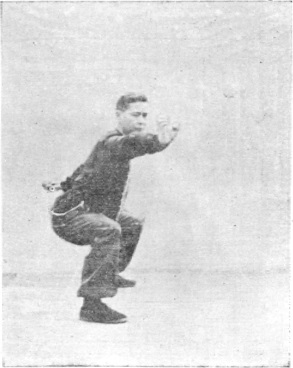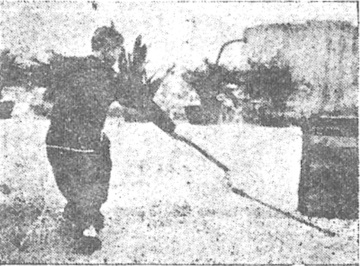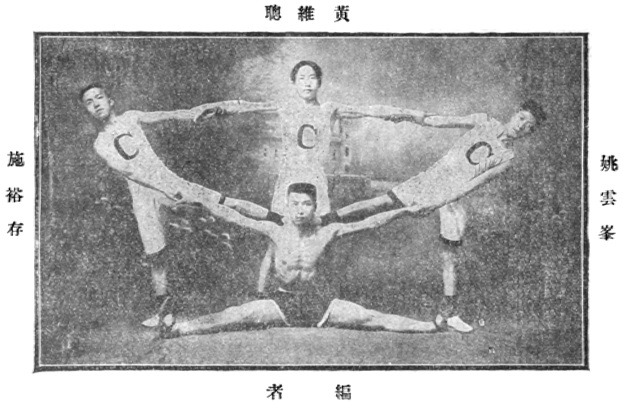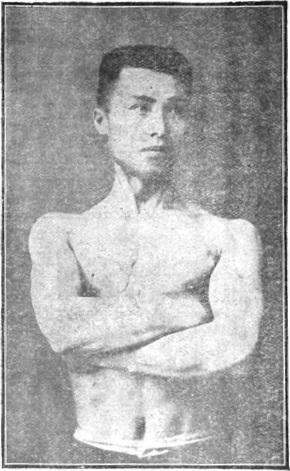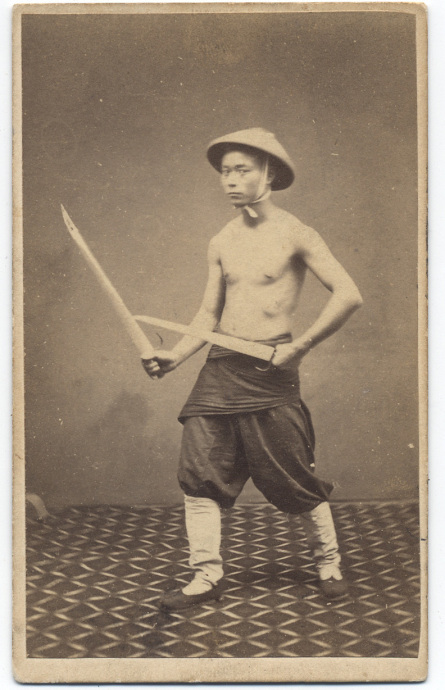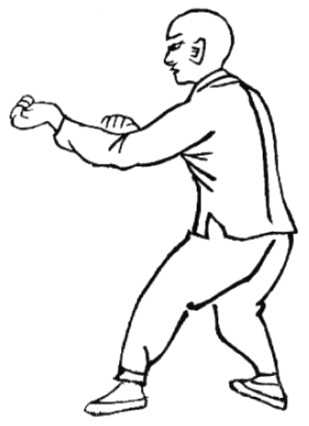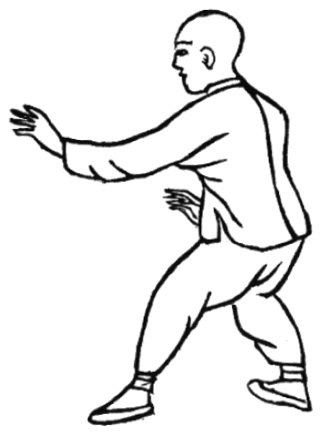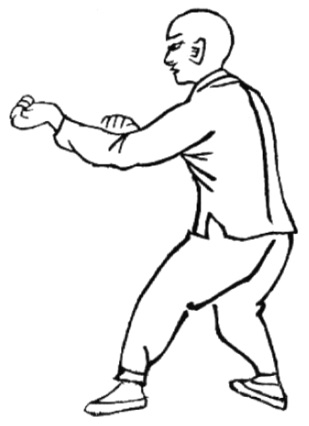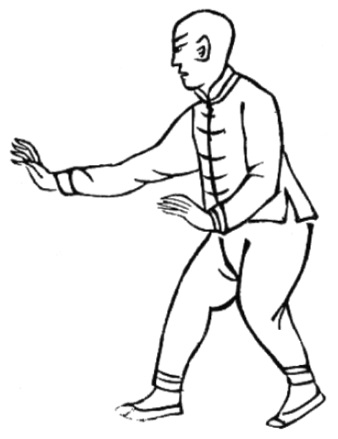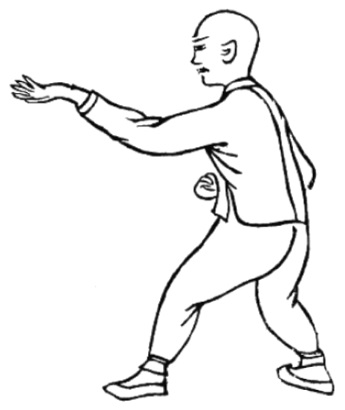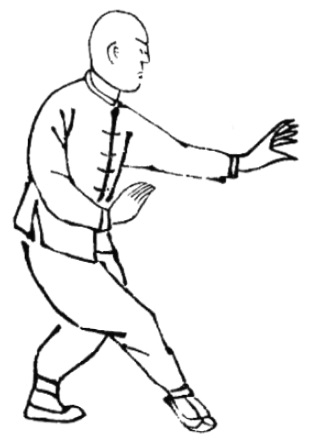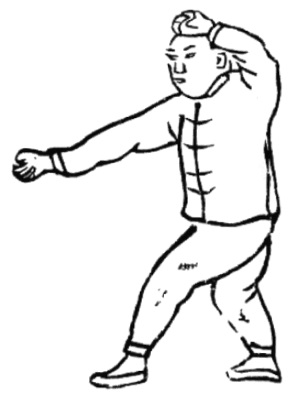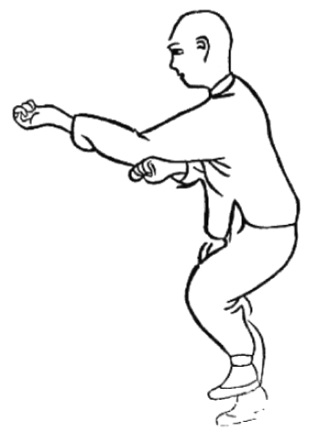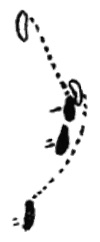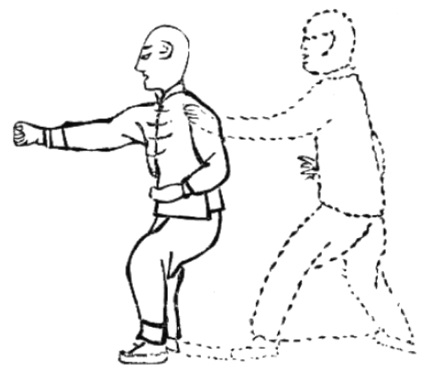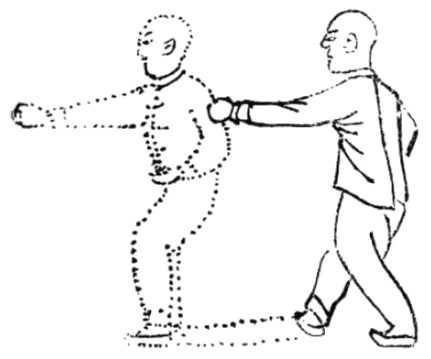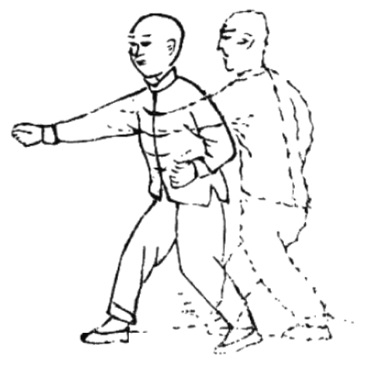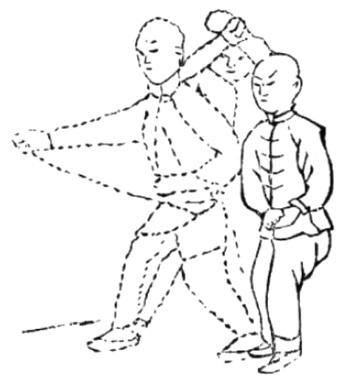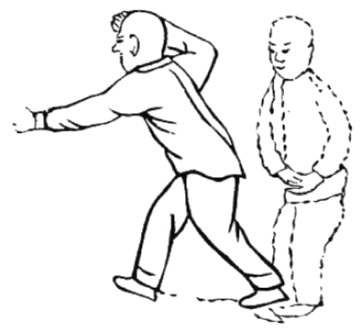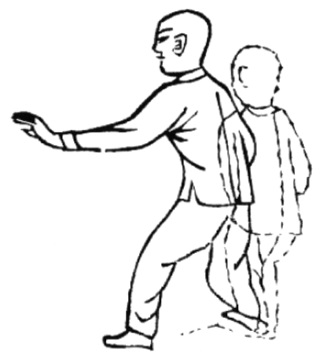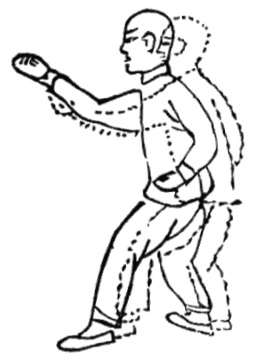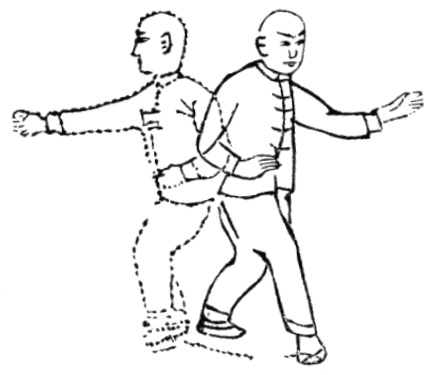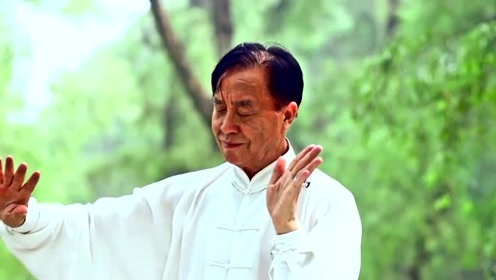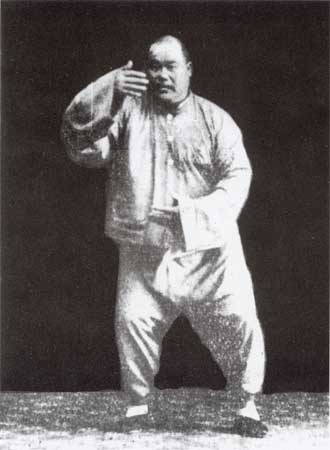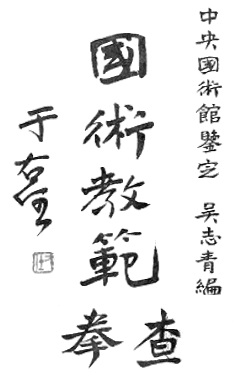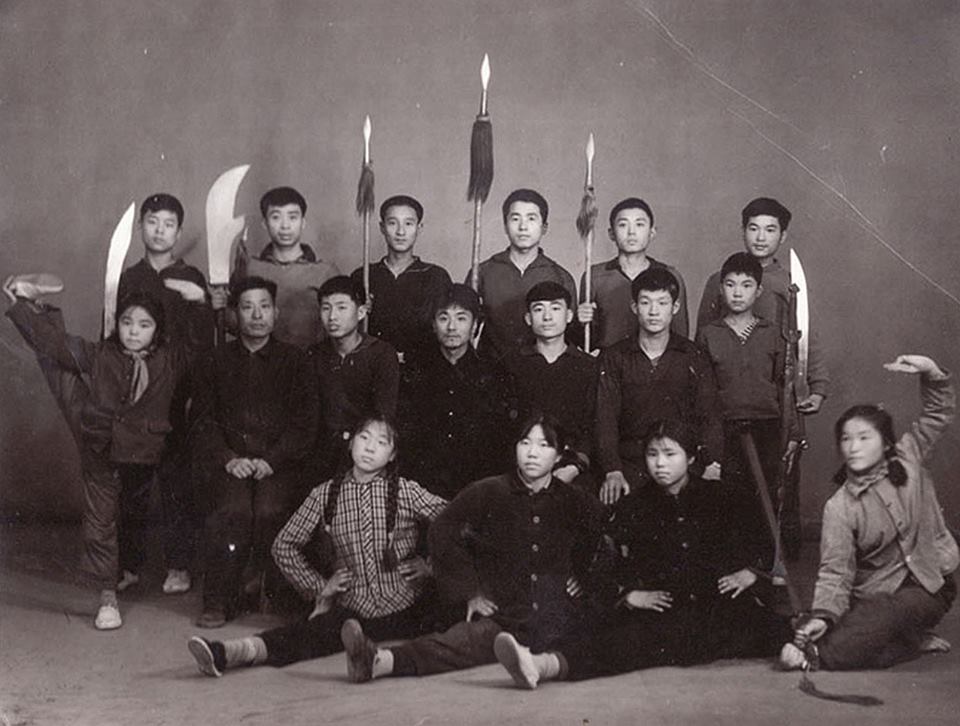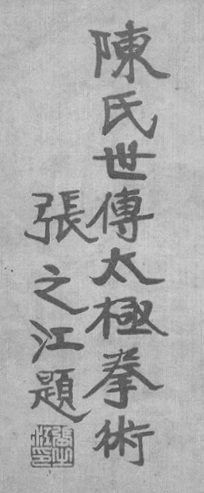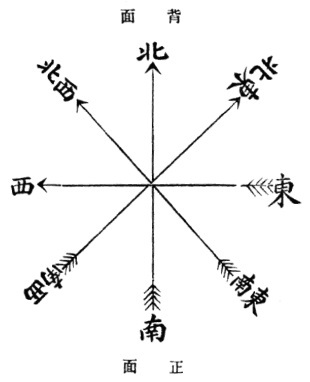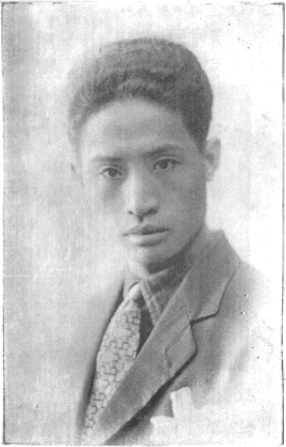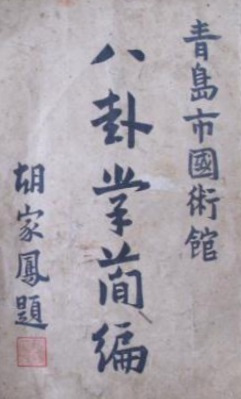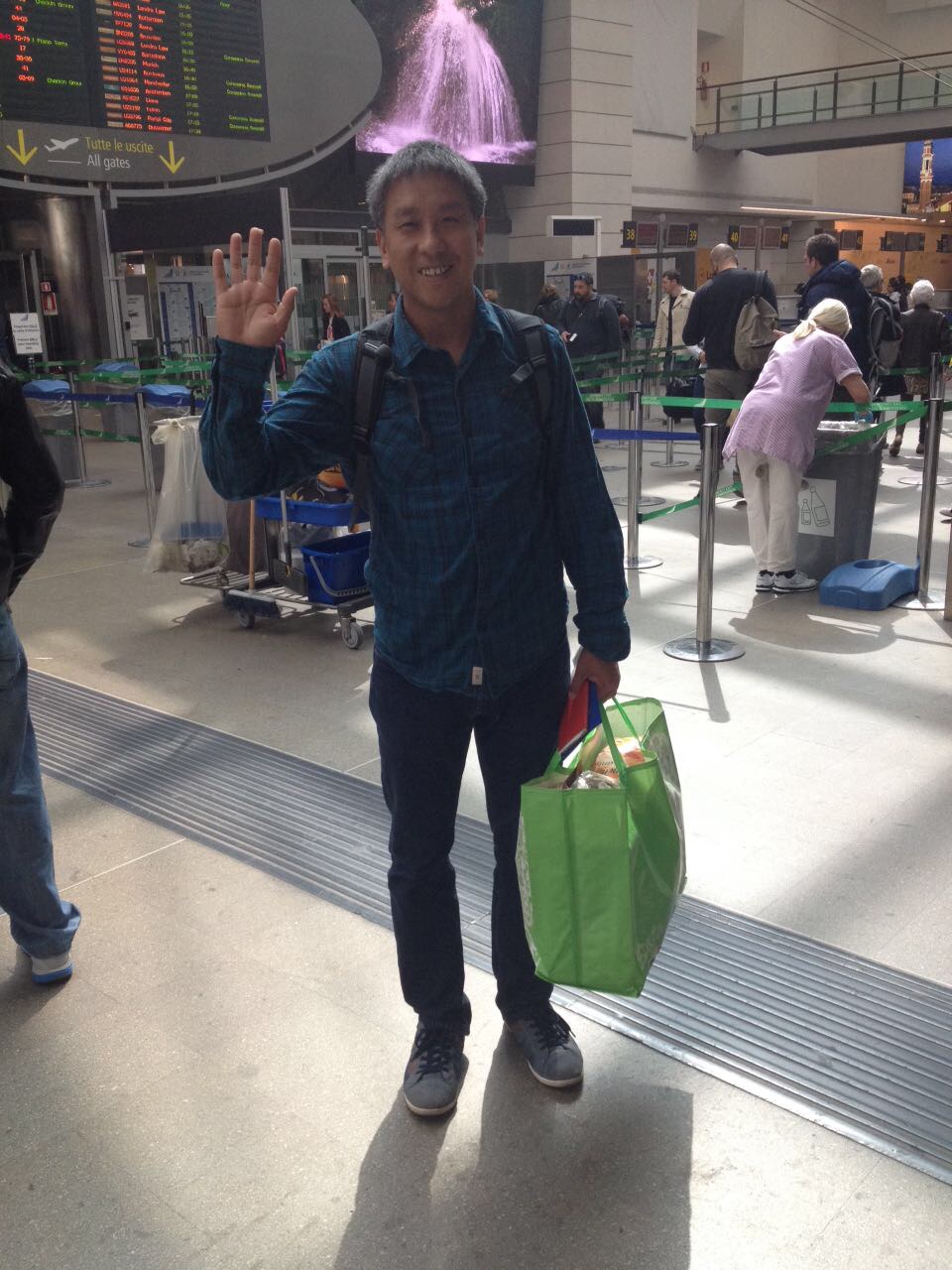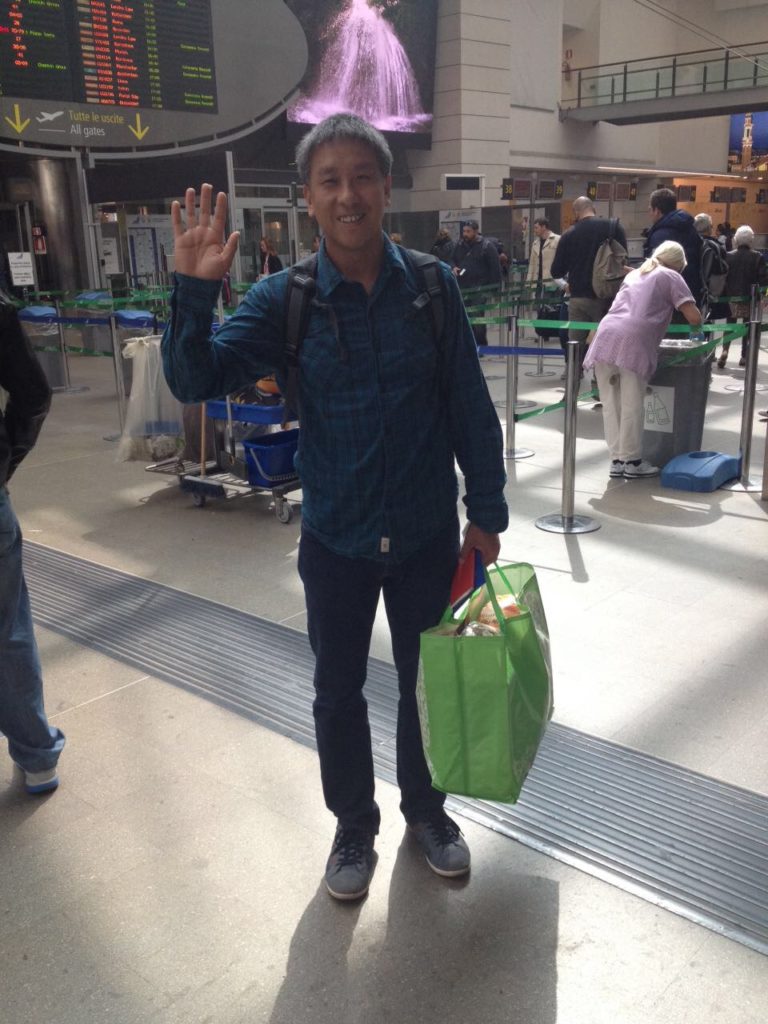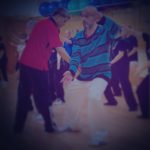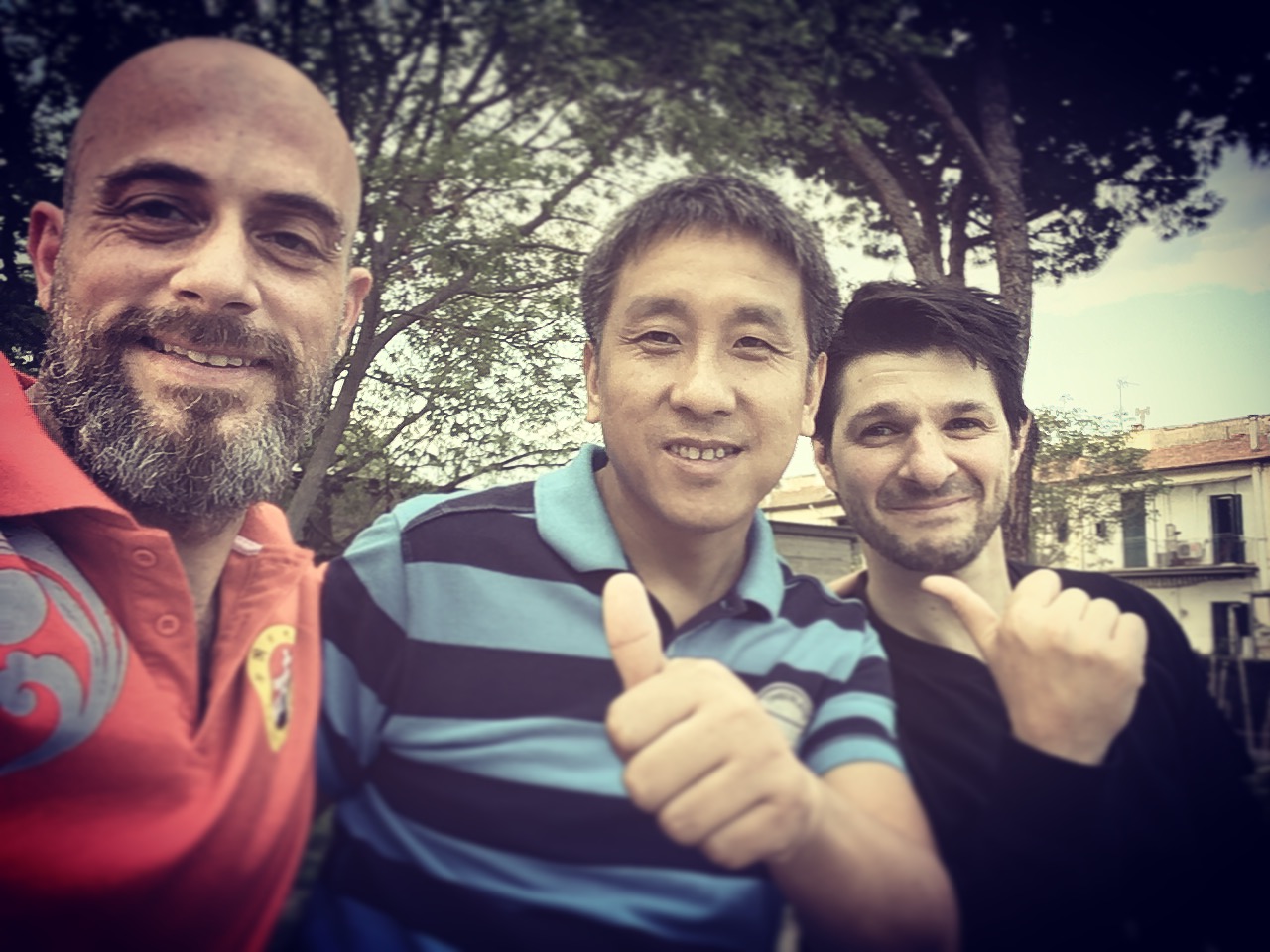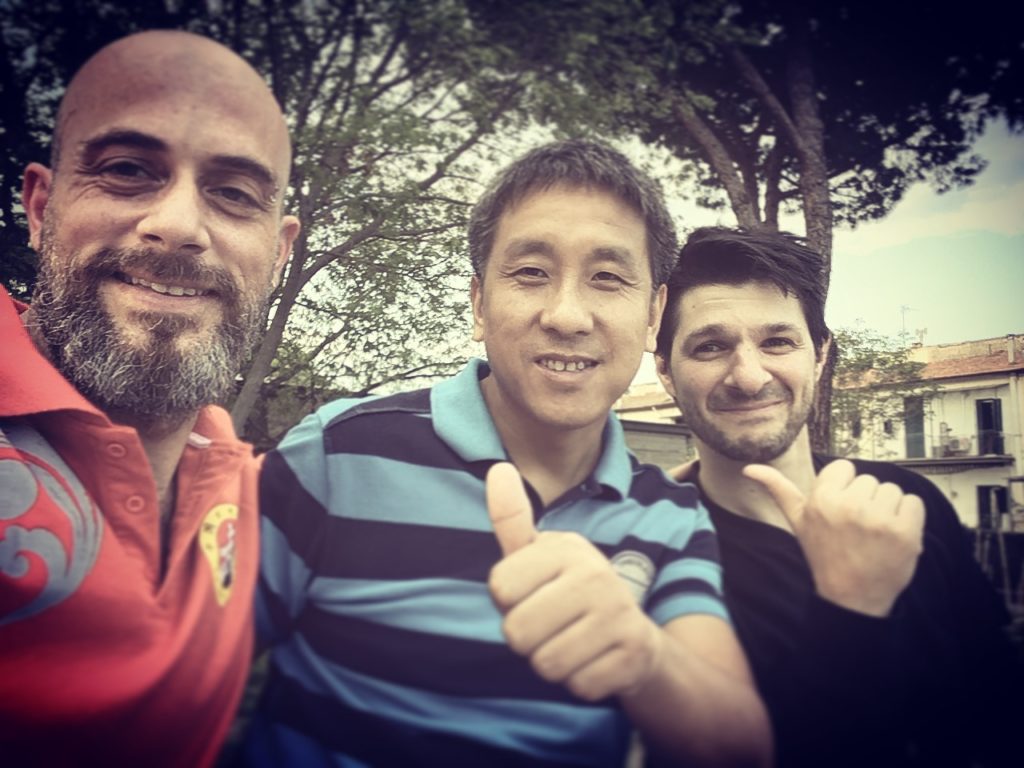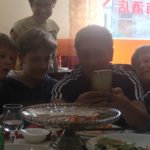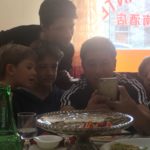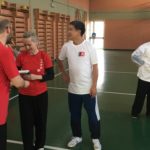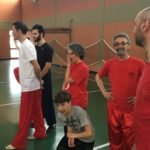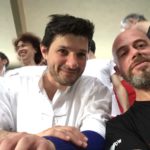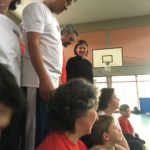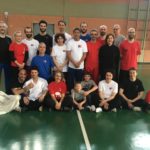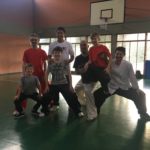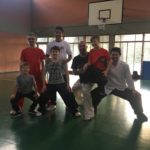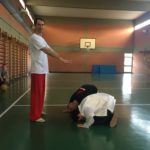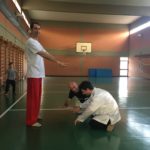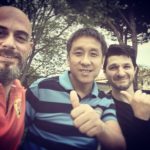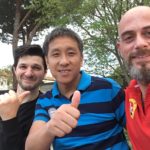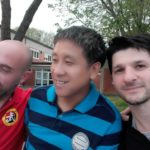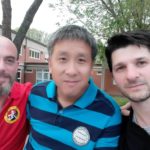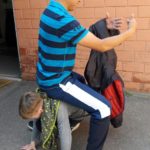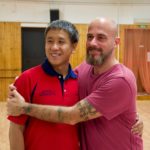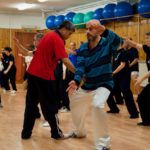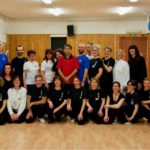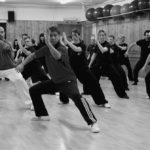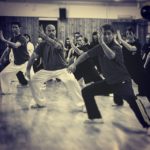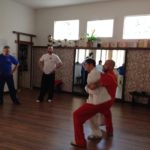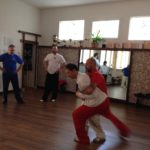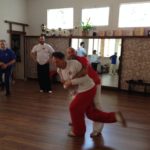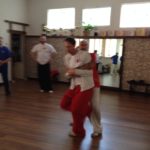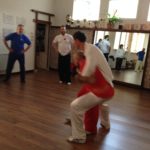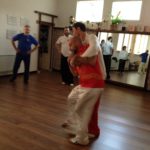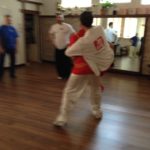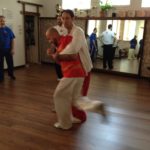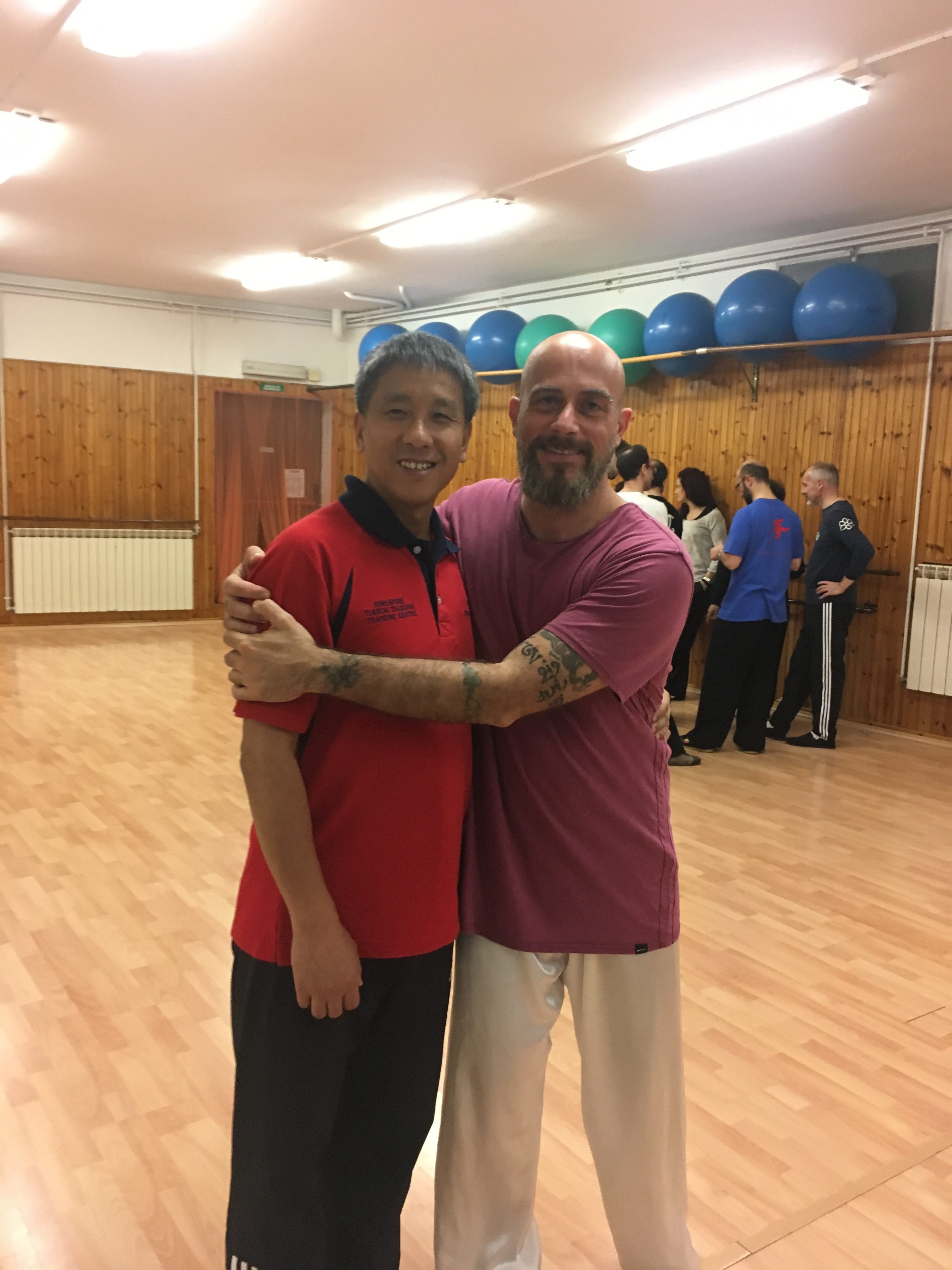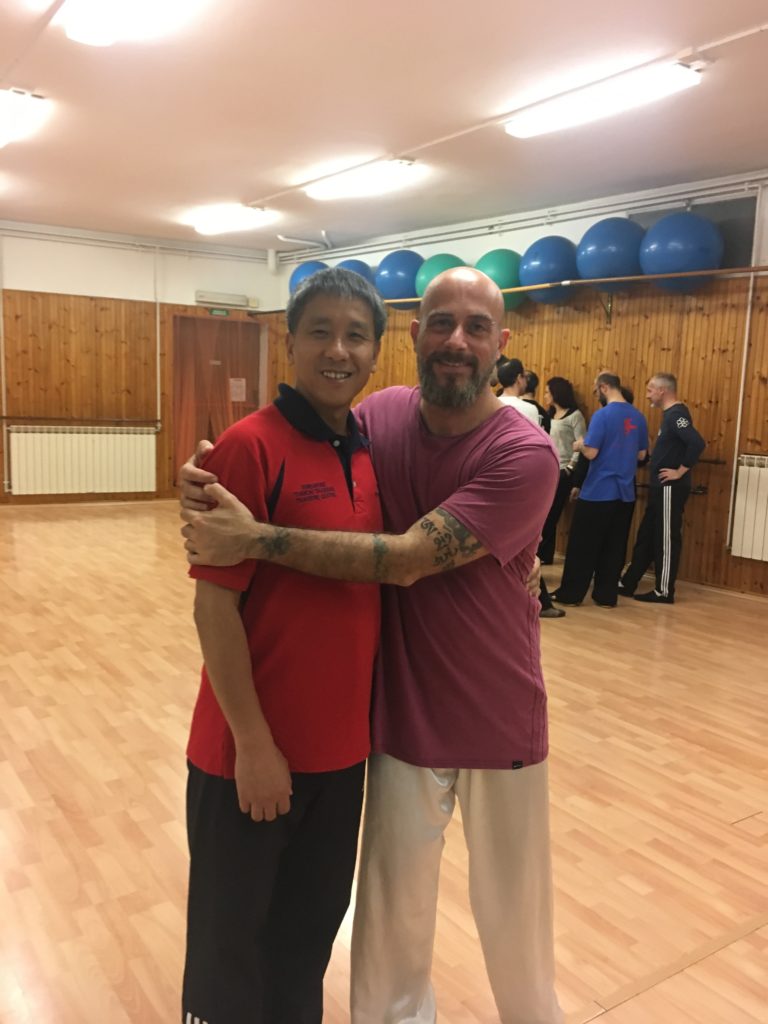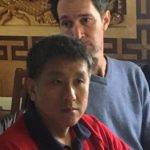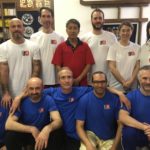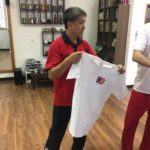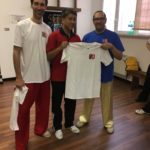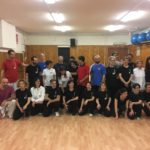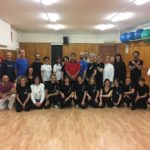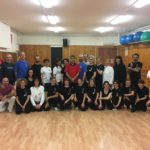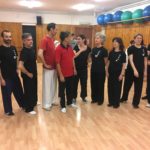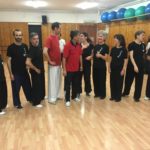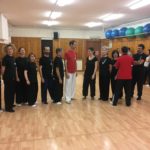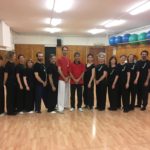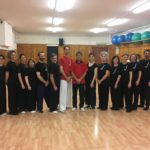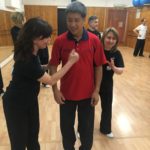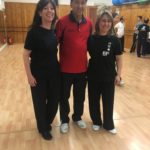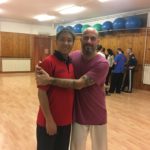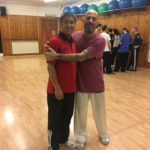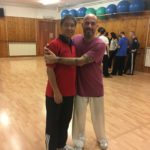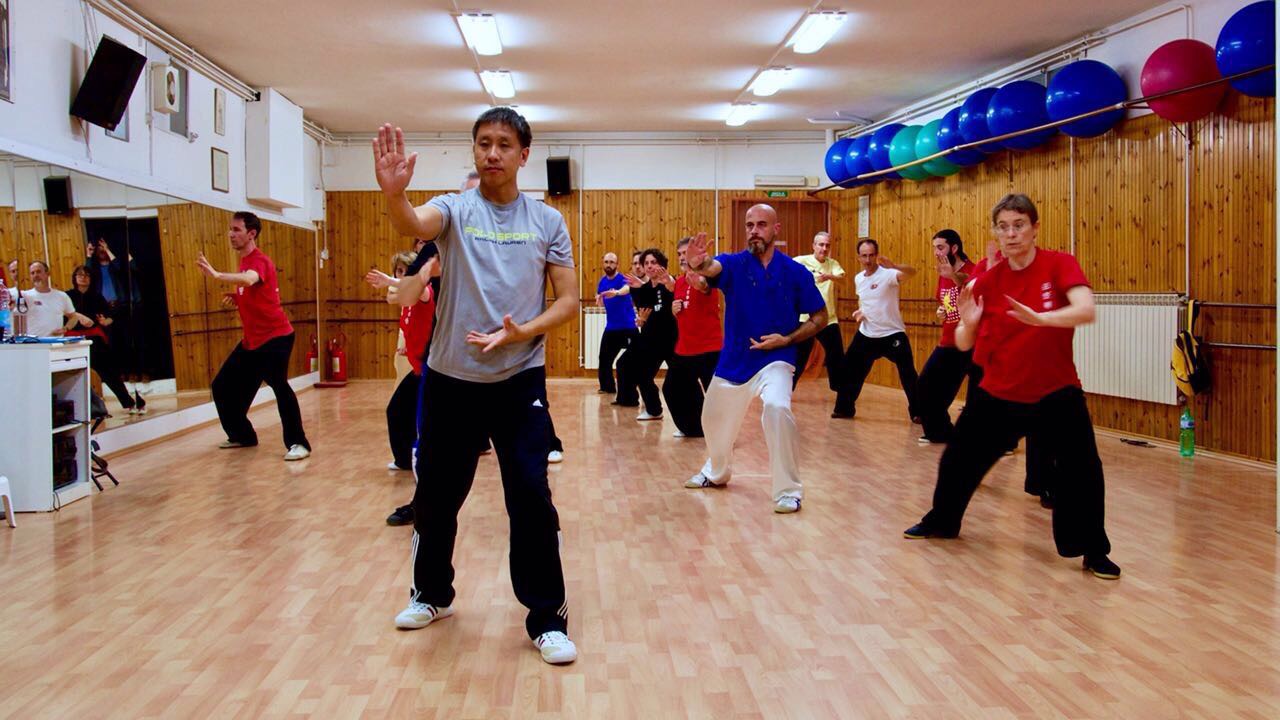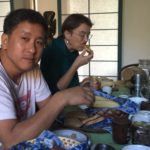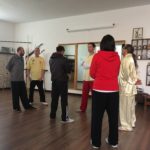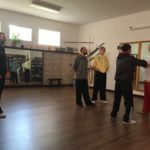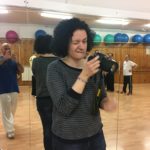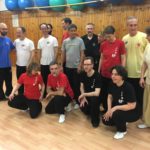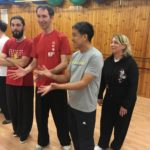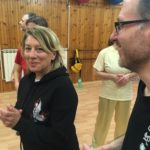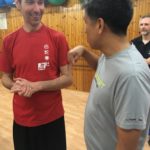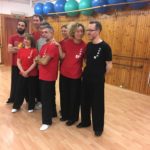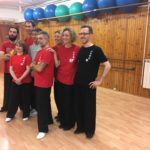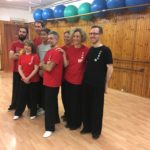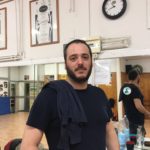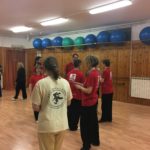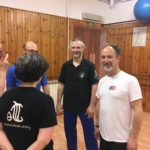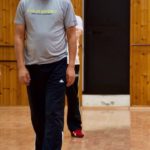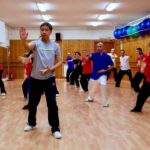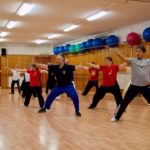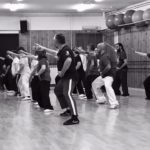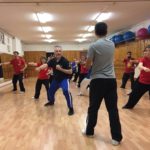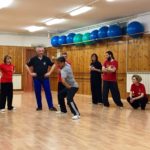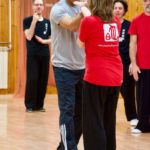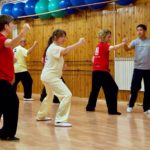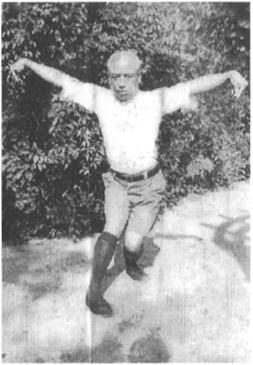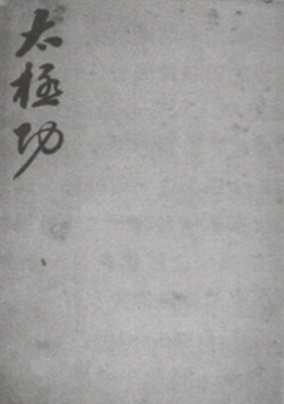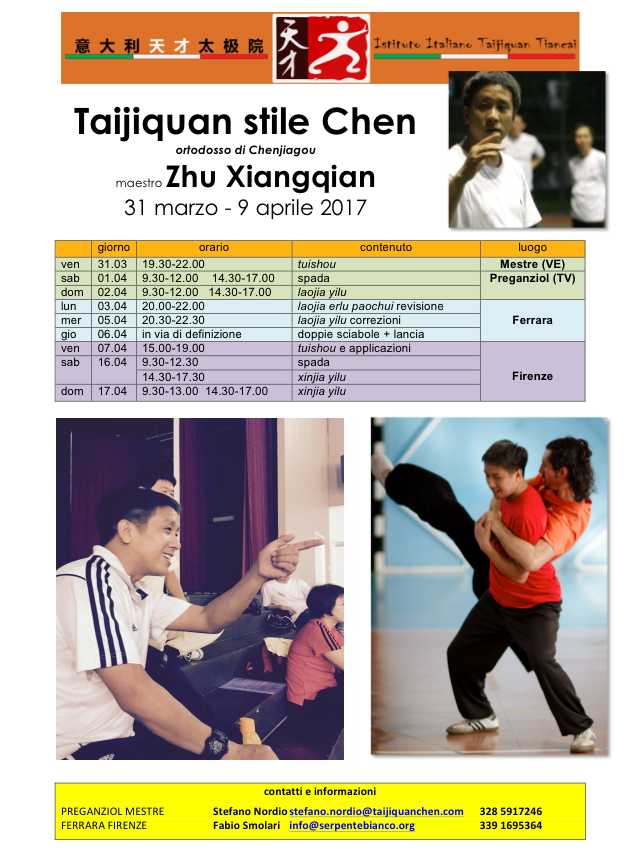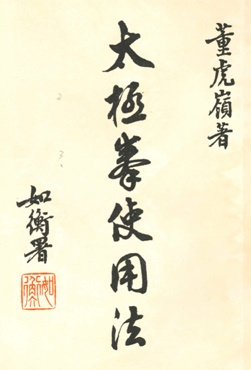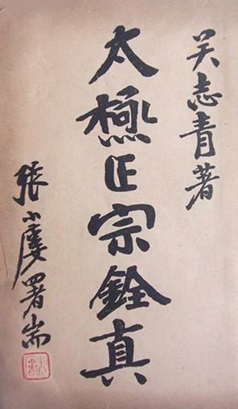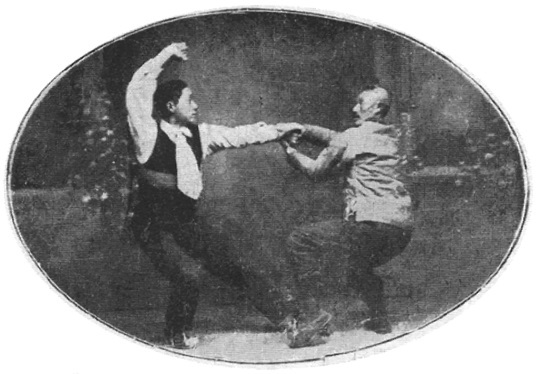–
國術教範查拳
A MARTIAL ARTS TEACHING MANUAL FOR CHAQUAN
吳志青
by Wu Zhiqing
張本源
postures performed by Zhang Benyuan
[published by 大東書局 Great East Bookstore, 1929]
[translation by Paul Brennan, Sep, 2017]
–

中央國術館鑒㝎 吴志青編
Authorized by the Central Martial Arts Institute: Wu Zhiqing’s
國術教範查拳
A Martial Arts Teaching Manual for Chaquan
于右任
– [calligraphy by] Yu Youren
–

編者吳志靑先生
The author, Wu Zhiqing
–

館長張之江先生玉照
Portrait of Director Zhang Zhijiang
–
國術敎範弁言
FOREWORD
居恆見國人稱日人為矮奴以其身軀之短小猥瑣名之以示輕蔑耳然日本自維新以還致力柔術提倡體育昔之短且小者今已頎而長矣反觀吾國以國人之體格與日人較恐將自慚弗如徵之每歲國人投考日本士官學校以檢驗體格而致落選者十之七八他國以東亞病夫譏我者今尚不能稍湔此恥國內學校雖間有摹擬西土體育如田徑球類乃衡之全民適形成其為少數人之貴族體育而吾國固有鍛鍊體魄之武術反漸次頹廢將成絕響吾人偶思及國民體育之現象撫今憶昔未嘗不惄然憂之夫我國國術上溯秦漢下迄明淸雖乏詳載之專書而其價値蓋已久彰普通拳術雖婦人稚子老叟病夫苟能稍嫺卽可化衰病為壯健易萎靡為英武惟以歷來武術家之秘密自封各宗派之鬥爭分裂重以離迷玄奧之神道思想重文輕武之社會觀念種種摧蝕遂致久積畧備之武術逐漸退化幾垂於絕或曰昔之武術僅備戰陣之用今則科學進步火器昌明雖十年煉臂十年煉目將焉所用轉質之歐洲治軍者乃云鐵彈之堅不如肉彈更察晚近世界之各大戰其最後勝利亦皆賴白兵肉搏而獲得衝鋒之江亦常待罪行間深悉突擊遠戰固需火器近接則嫺刺擊者常操勝算國術在軍事上之效用於斯益徵本館編國術教範查拳一書事蕆序此誌感研究而練習之尚期諸吾偉大之國民敢為弁言
中華民國十八年六月 張之江
I still notice my countrymen referring to the Japanese as the “short slaves”, as if their bodies are short, small, and ugly. The name is used as a pejorative. However, ever since the Japs have modernized their country, they have devoted themselves to Jujitsu and promoted physical education. They used to be short and small, but now they are big and tall. When we compare the physique of our own people to that of the Japanese, it has to be said that we are shamefully inferior. As proof of this, every year our countrymen sign up for the physical fitness exam at the Japanese naval academy [in Shanghai], and seventy-five percent of them flunk. Other countries ridicule us as “the sick men of Asia” and we are still unable to wash off any of this humiliation, even though schools in our nation have been imitating Western physical education, such as track and field activities, and ball sports. We have to take into account what is suitable for the whole populace, and these activities are a rather aristocratic form of physical education in that they suit only a small number of people. But we already have a means of training the physique: our martial arts!
Unfortunately, these arts have gradually been eroded to the point that they are almost lost. Whenever we think of the state of our physical education, no one who thinks back does not grieve. Our nation’s martial arts have been around from the dynasties of Qin and Han to the Ming and Qing. Although we lack detailed records in specialized books, it is at least clear that they were valued for a very long time. A typical boxing art is for everyone, whether woman or child, old or infirm. If one can develop even a slight level of skill, the training can transform a person from feeble to robust, from listless to valiant. However, martial arts masters through the ages kept their arts secret, and so styles feuded with each other over who had the most profound and magical system, and society meanwhile championed literary pursuits and denigrated martial arts. Both of these things had a corrosive effect. Consequently we have built up a long-standing neglect for martial arts training and gradually these arts have deteriorated and almost fallen away completely.
It has been pointed out that martial arts in former days were used only to prepare for war but nowadays, due to scientific advances, firearms are flourishing instead. Even after ten years of training the limbs and eyes, what use would it be? But European generals have said that the best artillery is still inferior to “human bullets”. Notice that in all the great battles of recent years, the final victory always depended on hand-to-hand combat to win the assault. I often had to threaten fearful men with punishment during my service in the army, so thoroughly did I understand the importance of getting them to charge. Long-range combat truly requires firearms, but close-quarter combat requires skill in stabbing and striking to be sure of success. The usefulness of the martial arts in the military is proven by this.
From this institute comes A Martial Arts Teaching Manual for Chaquan, which has just been finished. I here record my feeling for this event: through study and practice, there will come a time when our people will be mighty again, and I dare to proclaim it so.
- Zhang Zhijiang, June, 1929
–
國術敎範序
PREFACE
古之言治禮樂尚已。禮以射為重。樂以舞為主。射者必志正體直。神定思閒。然後命中。可以觀德。可以上功。其後騎射之術。流為兵家。安邊禦侮。代有聞人。至近世火器發明而寖衰。舞有干舞、羽舞、旄舞、帗舞之別。投步赴節。垂手側弁。亦將以明德象功也。其後雅樂不作。鄭聲雜奏。而驚鴻飛燕之舞姿。猶傳於樂府。余觀於此。而知古人於雍容揖讓之間。不忘武事。小心翼翼。良士瞿瞿。陶情淑性之節文。不離乎易筋洗髓之法則。此殆拳術之權輿也。今世拳術派別。不外內外二家。外家稱少林。祖高僧達摩。達摩以前無聞焉。內家稱太極。祖丹士張三丰。三丰以前無聞焉。二子者。近則宋。遠則梁。洵如寧波府志所載。得自神授耶。抑拳法亦與佛法同來自天竺耶。何以孟子所引北宮黝、孟施舍之養勇。一則不膚撓。不目逃。刺萬乘君若刺褐夫。一則不能必勝。而能無懼耶。又何以漢書藝文志。有手搏六篇。列入兵家。而司馬遷傳。有張空拳冒白刃語。皇甫嵩傳。又有雖兒童可使奮拳以致力語耶。北宮黝之勇近外家。孟施舍之勇近內家。惜其養勇之術無傳焉。手搏六篇。亦屬逸書。顧名思義。搏訓擊取。是達摩三丰之前。吾國確有拳術專家與專書矣。彼二子不過精於斯道。後人不能溯師承所自。遂奉為不祧之祖耳。夫以神明華胄之裔。文物禮制。郁郁彬彬。而顧無行健自強之術。以養吾勇而作吾氣。則華夏早淪於夷虜。民族早歸於凋喪矣。是故射為君子所必爭。舞為周禮所備載。發揚蹈厲。有勇知方。古本無重文輕武之弊也。慨自後世學術傳授。恆出祕密。不輕著述。昭示衆人。於拳技尤甚。以不公開討論之故。自不如近代科學有原則定律。足供尋繹日進不已。往往得自天才。傳以口訣。精微奧妙。與人俱亡。其糟粕之矢石刀馬。徒為莽夫博取功名之資。甚則短打長把。舞臺伶工。猶模仿一二表演英烈。此外則拳師鏢客。私相受授而已。學士大夫輒羞為之。陳亮序酌古論曰。文武之道一也。後世始歧而為二。文士專鉛槧。武夫事劍楯。彼此相笑。求以相勝。各有所長。時有所用。豈二者卒不可合耶。余少喜外家拳。長治文史。漸不屑為。及游東瀛。覩彼國人對於柔道。劍術之勘摯不懈。乃恍然其强國之故。鍛鍊國家。固應自鍛鍊國民始。且其鍛鍊之術。多由吾國襲取而得。彼羅拜歐化之流。並以西式體操為已滿足。而遺棄吾國固有之武術者。不已更足誚乎。今國民政府為發揚吾族固有之文明。首開國術館於新都。並徧設分館於全國。請張子薑先生掌其事。聚海內名家講求國術。期年而風氣丕變。街談巷議。不出拳脚。文人韻士。亦寖知讀拳譜習步法矣。該館編審處處長吳君志靑。更就平日實際教授所得。編為國術教範。附以圖解。撮其用法。定位行拳。瞭如指掌。將以第一編刊行問世。而徵余序之。余於此術荒疎實甚。第知此為强種强國之布帛菽粟。固未可須臾離者也。謂宜以公開研究。變革祕傳。以科學方法。推演拳技。尤宜使智體俱進。文武一道。教範之作。庶幾大輅之輪椎也歟。
民國十八年五月十八日山右王用賓序於南京立法院
There is much esteem in ancient writings for rituals and music. The most important ritual was archery, and the emphasis in music was upon dance. An archer had to correct his mentality and straighten up his body. With his spirit calm and mind at ease, he could then hit the target. Thus could be observed both his virtue and skill. If he then demonstrated skill with archery while on horseback, he would qualify as a military commander, sent to pacify borders and repel invaders. Through the dynasties, there were many men who gained fame in this way, but by modern times, the invention of firearms caused such rituals to gradually fade away. As for dancing, there was baton dancing, plume dancing, banner dancing, ribbon dancing, and so on. Rhythmic steps and elegant hand gestures exhibited both virtue and skill. Courtly airs later gave way to more melodic music, with a wider range of instruments, and the movements of dance became more graceful and nimble.
From reading surviving songs and poems, I know that amidst the dignity and courtesy of ancient people, they did not forget martial affairs, which they attended to with great care and gentlemen treated with great respect. Their ceremonial rituals for cultivating a sense of ease and refinement were not that far from the methods of Sinew Changing and Marrow Washing. This seems to have been the beginning of our martial arts.
Modern martial arts styles do not go beyond the two schools of internal and external. The external school is called Shaolin and descends from the eminent monk Damo, there being no one of that school who existed prior to him that we know of. The internal school is called Taiji and descends from the elixirist Zhang Sanfeng, there again being no one of that school who existed prior to him that we know of. Zhang is more recent, living during the Song Dynasty, whereas Damo lived as far back as the Liang Dynasty. According to the Records of Ningbo Prefecture, Zhang obtained his art divinely [being taught in a dream by the “Dark Warrior” Emperor (i.e. a Daoist “god of war”)]. Similarly, Damo’s boxing techniques seem to be Buddhist methods coming from India.
In Mengzi [chapter 2a], there is the description of Bei Gongyou and Meng Shishe “cultivating courage”: “Bei Gongyou did not flinch at pain nor shy his eyes away from anything, just as willing to stab an emperor as he was to stab a peasant… Meng Shishe felt that one could not be sure of victory but could at least be free of fear.” In the “Bibliographical Records” of the Books of Han, there is mention of “six chapters on bare-handed fighting” listed among military texts. From the bio of Sima Qian [Li Guang] [Books of Han – bios, part 25]: “A warrior will dare to fight bare-handed even at the risk of naked blades.” From the bio of Huangfu Song [Books of Later Han – bios, part 65]: “Even a boy can devote himself to boxing.”
Bei Gongyou’s courage was like that of the external school, and Meng Shishe’s was like that of the internal school, but unfortunately their methods for cultivating courage were not passed down. The “six chapters on bare-handed fighting” are also lost works, and as the name suggests, were presumably lessons on wrestling and striking. This means that prior to Damo and Zhang Sanfeng, our nation did indeed have boxing arts experts and specialized texts. Damo and Zhang were nothing more than masters of their arts, but since later generations have not been able to trace back to the source of those arts, they revere those men as the earliest ancestor of each, treating them as descendants of divine beings or of royalty.
In the midst of traditions of conduct that were elegant and refined, it was felt that without arts of invigorating activity for self-improvement [paraphrasing from the Book of Changes, hexagram 1: “Nature acts with vigor. Likewise a gentleman ceaselessly improves himself.”], in order to cultivate one’s courage and build up one’s energy, then China would have long ago slipped into being a nation of barbarians, and its people would have withered and died off. Therefore archery was a compulsory competition for gentlemen and dances were recorded in the Rites of Zhou. There was glorification and emulation of those who had both courage and proper conduct, and so in ancient books we do not find the error of over-emphasizing the civil and trivializing the martial.
Alas, though later generations passed down these arts, they persisted in keeping secrets, not lightly sharing knowledge with everyone. This is a problem in martial arts in particular. To not discuss ideas publicly is contrary to the rules of modern science. Supplying information to be re-evaluated leads to endless progress and constantly produces more talented individuals. Pass on the secrets of your art, every profound subtlety, or they will pass away with you.
At the bottom of the barrel, martial artists ended up serving as soldiers under braggarts who had not earned their rank honestly. Better off, martial artists performed stage-fighting, imitating heroes in a few plays. Beyond these things, boxing masters were often caravan escorts, simply making a living. Whatever the case, scholarly gentlemen were embarrassed to be in their presence. Chen Liang [of the Song Dynasty] wrote in the preface to his Considering Ancient Theories: “The ways of civil and martial started out the same. It was in later generations that they branched off into two things. The scholar is focused on pen and page, whereas the warrior is concerned with sword and shield. They mock each other and seek to succeed over each other. [In times of peace, the scholar wins. In times of conflict, the warrior wins.] Each has his strengths and his moment to be useful, so why can they not be in accord?”
When I was young, I enjoyed external boxing arts, but when I matured, I studied literature and history, gradually developing a disdain for martial arts. Then I traveled to Japan, where I observed their countrymen studying Judo and Kendo with an untiring sincerity, and I suddenly realized that the means of strengthening a nation is by strengthening its people. We surely should begin to exercise our people and train their skills. Our nation has effectively been taken over, giving in to the surrounding Western influence, and so it has become satisfied with adopting Western calisthenics. But we have abandoned our own martial arts in the process, for which we should feel endlessly guilty.
Therefore the National Government is now exalting our nation’s innate culture. First a Martial Arts Institute was opened in the new capital [Nanjing] and further institutes are being established everywhere in the nation. Zhang Zijiang [Zhijang] was appointed to manage this enterprise and he has gathered together martial arts masters from throughout the nation. The institute has just had its first anniversary [having opened in Mar, 1928] and there is a mood of great change having been achieved that is being talked of all over town, for this is not just a matter of punching and kicking. Even scholars and poets have gradually learned to appreciate boxing manuals and are practicing the movements.
Much is owed to the head of the institute’s editing department, Wu Zhiqing, who has taken a typical example of the curriculum to make A Martial Arts Teaching Manual, including descriptions of movements, pointers on application, and orientation directions for how to move through the practice routine, all made perfectly clear. For this first volume of such publications, a preface was requested of me. Although I am quite out of practice with these arts, I know that they are the essentials [“the clothing and food” – equivalent to “the bread and butter”] of strengthening the people to strengthen the nation, and that there is not a moment to lose. I say that we should publish such research and transform secret teachings [into public knowledge], use scientific methods to analyze boxing skills, and especially that we should get theory and practice to advance together, the ways of the scholar and warrior merged into one. With the producing of teaching manuals, perhaps we can “hammer the wheels of the larger cart” [i.e. fix the large-scale problem].
- written by Wang Yongbin of Shanxi at the Nanjing Legislative House, May 18, 1929
–
自序
AUTHOR’S PREFACE
世界原無新物。特本諸原質,各盡其發明製造之能事而已。世界亦無新理。特本諸自然,各盡其尋繹推演之心力而已。一代之技能,有一代之應用。一國之技能,有一國之特性。古代之技能,或不適用於今世。歐美之技術,亦未竟適於中國。其環境不同,思想各異故也。革命以還,凡百建設。將次頽廢之國術,亦得復興。本館乘時而起。張公子薑,主持其間。慘淡經營,以期達强種救國之目的。草創迄今,成績斐然。各省市縣分支各館,爭先成立者,已達全國三分之二有强。但欲作普遍之運動,非藉文字之宣傳不為功。依照吾國民族之特性,及歷史與環境之背景;苟欲達到强種救國之途:將藉重西洋之體操乎?抑恢復固有之國術乎?詳加究察,不問可知。雖然:處此科學昌明之二十世紀,非講實用,不能圖存。國術之所以日見式微者,卽在缺乏尋繹推演之心力,墨守成法,不知改進故耳!
幸明達之士,有鑒於斯,竭力提倡。各家各派,風起雲湧,各展所長,力求改進。一派以考據名於世。一派以玄理炫於時。一派以科學相號召。一派以折衷為提倡。而詳察考據之新著,殊不多覯。間有圖說,尚闕理論。玄理派以孫祿堂先生之太極拳等書,為最近之表現。科學派以章乃器先生所著之內功拳的科學基礎一書,詳說理論。及拙著中國新體操為理法幷論之創作。折衷派以馬子貞先生所著之中華新武術為調劑各派之著述。
以上僅舉其略,以供國術同志之研究。唯按之科學原理,陳義太高者,不切於事實。使人目眩神移,頗難循序而進。而不顧生理之需要,近於矯作之運動者,尤為現代教育所不取。
是以承館長張公之命,編輯此書。每式附以用法,圖說,式定名詞,法釋應用,圖明動作,說解意義。順次推進,以圖適世界之潮流,作研究之借鏡;鍛我體魄,强我國魂。志靑雖不才,是為厚望!
中華民國十八年四月古歙吳志靑序於中央國術館編審處
The world originally had no new things in it, just some basic elements, but they were eventually worked into skillful inventions. There also used to be no new ideas, just some natural phenomena, but through thoughtful analysis, underlying principles were eventually deduced. The skills of an era serve the function of that era. The skills of a nation have the character of that nation. The skills of antiquity sometimes do not suit the modern world. The skills of Europe and America are not entirely suitable for China. Different circumstances, different ideas.
Since the Revolution [1911], so many things have had to be rebuilt, and thus faded martial arts will also be revived. This institute is seizing the moment to do so. Zhang Zijiang has taken charge of the situation, persistently putting forth painstaking effort in hopes of achieving the goal of strengthening the people and rescuing the nation. What has been done so far is a great accomplishment. People are hurrying to establish an institute in every province, city, county. Already two-thirds of the country is being strengthened. However, if we want to make such exercise universal, it cannot be done without the publishing of books.
They should suit the personality of our nation’s populace, and be in the context of our history and circumstances. If we want to achieve the strengthening of the people to rescue the nation, do we really need to rely on Western calisthenics? Should we not restore our own martial arts? Through meticulous research, what has not even been considered can be understood. Although we are now in the twentieth century, this era of flourishing science, if we do not discuss actually making use of science, we will be unable to survive. The reason why our martial arts are in decline is because of a lack of thoughtful analysis to deduce principles, simply a mindless adherence to established ways rather than an understanding of how to improve them.
Fortunately, wise experts have in view of this been doing their utmost to encourage such study. Each system and each style has received a storm of popular support [“winds rising, clouds massing”], each expressing its strong points and striving to improve where it lacks. One school may do textual research to share with the world. Another school may highlight old abstract theories to show off to the present. Another may make an appeal for more scientific knowledge. And still another may take a middle ground and advocate all of these approaches. New works of textual research are not often seen, for books still tend to have lots of pictures and lack in theory. For abstract theories, Sun Lutang’s Study of Taiji Boxing and his other books are a recent expression of this. For scientific awareness, Zhang Naiqi’s Scientific Internal Boxing Arts is a fundamental example, giving detailed explanations of principles, as well as my own clumsily written China’s New Calisthenics. For the middle ground, Ma Zizhen’s China’s New Martial Arts uses each approach equally.
Given above is simply some brief information about the studies of martial arts comrades. In accordance with a scientific mindset, if we overly glamorize any approach, it will cease to correspond to reality, causing students’ eyes to be dazzled and their minds to be distracted, making it difficult to progress in the proper order of training. Students would then pay no attention to physiological requirements and end up forcing themselves through the exercise, which is not at all what modern education is seeking.
Therefore, carrying out the order of Zhang Zhijiang, I have compiled this book. With each posture is included its function and a description. Equipped with the name of the technique, explanation of the application, and description of the movement, its significance will be clear. Progress through them in sequence and make use of the common trend, learning from the experience of others. We will train our bodies and strengthen our national spirit. Although I have no talent, I do have great hopes!
- written by Wu Zhiqing of Guxi [in Anhui] at the Central Martial Arts Institute’s editing department, Apr, 1929
–
凡例
GENERAL COMMENTS
一此編取材於查拳第四路,分為二章。第一章緒論。第二章單練。
– This book showcases the fourth set of Chaquan. It is divided into two parts: part one – introductory material; part two – the solo set.
一此編依教育程序。一章分四節。每節分三段。每段分四式。每式附以用法,圖說,式定名詞,法釋應用,圖明動作,說解意義。使學者一目了然,易於練習。
– This book complies with the teaching procedure of the set being divided into four parts, each part divided into three sections, each section divided into four postures. With each posture is included an explanation of its function and a description of the movement. Equipped with the name of the technique, explanation of the application, and description of the movement, its significance will be clear, enabling you to understand at a glance and practice easily.
一此編教授團體,可參照軍事教育法行之。
– As this book is designed for teaching whole groups, it can be referred to for methods of giving drill instruction to the army.
一此編各式有口令,原為初學便利起見。習熟後,可由繁入簡,一氣呵成。以不違古人定法,近代教育程序為原則。
– In this book, there is a command for each posture to make it easier for beginners to know what to do. After they are familiar with the movements, they can move on from such details and simply flow through the set. So as to not violate the principles of our forefathers and yet teach with a modern procedure, there is this way of doing it.
一此編假定行拳方位,為初學便於記憶而設。練熟後,則不拘方向。
– With this book, practice takes place facing certain directions. This is so that beginners can easily memorize and establish themselves in the material. After practicing it until it is familiar, you can face any direction.
一此編謌譜為自昔所傳,讀其語句,多費索解。但因尊重原著起見,未便擅改,致失其眞。
– The instructional songs in this book were passed down from long ago. Reading through their phrases, there are often parts that are difficult to explain, but out of respect for the original material, let us not alter them and end up losing the authentic version.
一此編所定術名,或因便句讀,或切於實用,或想像形式以定之。考我國武術名詞,各家各派,分歧不同,或各套動作同,而名詞則異。此為深中祕密之害,實武術界一大缺點也!用特聲明。
– The names of the techniques in this book sometimes represent a kind of simple punctuation between the postures, sometimes separate distinct applications, and sometimes provide poetic visualizations as to how a posture should look. Examining the terminology of our nation’s martial arts, each system and each style has divergent usages. Sometimes movements are the same but the names are different [or vice versa]. This is one of the harms of keeping things secret and is truly one of the greater shortcomings in the martial arts world, thus I specially point it out here.
一此編為本館教授班之講義,並以供諸同志之參考。
– This book was made to be teaching material for use in our school, but we offer it to all our comrades for their reference as well.
一此編掛漏之處,在所不免。尚祈國術同志,加以指正!
– This book inevitably has something about it that is incomplete. I hope my martial arts comrades will give me corrections.
–
四路查拳
FOURTH SET OF CHAQUAN
第一章 緒論
CHAPTER ONE: INTRODUCTION
第一節 國術之替興
Part 1: The Fall & Rise of Martial Arts
國術一道,湮沒不彰者久矣!憶及庚子一役,國人曾病帝國主義之壓迫,國勢因之日削。於是義憤塡膺,聯絡武術界,組織義和團。挾紅燈白蓮諸邪術,假神道之名,以扶淸滅洋相號召。遂召八國聯軍之禍。至使外人反以拳匪目之!詎知紅燈白蓮,皆係左道感人,與武術風馬牛不相及。未可以邪誣正。嗣武術界同志,積不能平。深信術有眞傳,足以强國禦敵,不甘受外人之蔑視。北方則有李存義李景林諸先生。設武士會於天津。許禹生孫祿堂吳鑑泉劉月亭諸先生。先後設體育研究社,及國技研究社於北平。馬子貞先生,設武術傳習所於濟南。霍元甲陳公哲諸先生,設精武體育會於上海。劉崇峻先生,設武士會,及國技學校於成都。志靑不敏,亦糾合同志,創辦中華武術會,及體育專門學校於上海。撮其大略:二十餘年,改良提倡,風行全國,已具相當成績。此為武術之復興時代。迨民十六,中央奠都南京。黨國領袖,以武術為强種救國之要素,羣力倡辦,於去年春,成立中央國術館於首都。博延國術人材,共同研究。復以科學方式,詳加整理。力求適合教育之原理,衞生之需要,且本心理學功用以支配。其剛柔繁簡,期與學者年齡,不相違背。他如廣發刊物,以資宣傳;招班教授,以廣後進;舉行國考,以拔眞才:迄至於今,省市分館,逐報成立者,已幾有全國之半。國術普及,可立而待。茲為國術教育統一起見,審愼教材,編輯教範,暫作過渡之範本。惟是素無專書,苦乏參考。挂漏之誚,所不免焉!
That martial arts as a whole have been falling into oblivion was not apparent for a long time. Recall that at the time of the Battle of 1900 [i.e. Boxer Rebellion], our countrymen were oppressed under imperialism and our national strength was consequently being whittled away. Filled with righteous fury, these men united the martial arts community and formed the Righteous Harmony Society. Embracing the sorcery of Red Lantern Zhu and the White Lotus cult, they became famous for their “magic” ways, and their motto was: “Support the Qing! Exterminate foreigners!” This invited ruin from the Eight-Nation Alliance [Austria-Hungary, France, Germany, Italy, Japan, Russia, UK, USA] by instead making foreigners intent upon opposing the rebel Boxers.
Surprisingly, the Red Lantern and White Lotus always depended on fake performances to move the hearts of people, using ways that were actually totally unrelated to martial arts. And so one cannot really slander these arts as fake sorcery or look down upon the inheritors of these arts. We firmly believe that these arts are authentic teachings, sufficient to empower the nation and fend off its enemies, and we will not willingly accept the scorn of foreigners.
In the north, Li Cunyi and Li Jinglin have established the Warriors’ Society in Tianjin. In Beijing, Xu Yusheng, Sun Lutang, Wu Jianquan, and Liu Yueting established first the Physical Education Research Society and then the Martial Arts Research Society. In Jinan, Ma Zizhen has established the Martial Arts Teaching Bureau. In Shanghai, Huo Yuanjia and Chen Gongzhe established the Jingwu Athletic Club. In Chengdu, Liu Chongjun has established a Warriors’ Society and the Martial Arts Academy. Also in Shanghai, since I am not smart enough on my own, I gathered together comrades, and we have established a Chinese Martial Arts Society and a Physical Education College.
In a nutshell: for more than twenty years, these arts have been getting increasingly promoted and are now popular throughout the nation, which is an achievement in itself. This is the era of martial arts revival. Since the government made Nanjing the capital in 1927, the party leaders have considered martial arts to be the key factor in strengthening the masses and rescuing the nation, and have all been strongly advocating such a way forward. Last spring, they established the Central Martial Arts Institute in the capital. They sent invitations to martial arts experts everywhere to come study together and then make use of scientific methods to carefully arrange a curriculum. These experts have been striving to arrange material in order to suit the principles of education, the requirements of health, and improved psychological functioning. An art’s hardness or softness, complexity or simplicity, must be appropriate to a student’s age.
Other projects include widespread publication of periodicals to better spread information, recruiting teams of instructors to extend this knowledge to the younger generation, and holding national tournaments to draw out genuine talent. Furthermore, there are now branch institutes being established one after another in the provinces and cities, already reaching half the nation. With our martial arts spread everywhere, we will be able to stand ready for whatever comes. This is the purpose of a unified martial arts education. We are scrutinizing teaching materials and compiling manuals to provide useful models to work from. Without specialized books, there is a frustrating lack of reference material. Feel free to reproach us for the incompleteness of this book, because it is inevitably lacking in some way.
–
第二節 國術性質之分析與本館職責之貢獻
Part 2: The Characteristics of Martial Arts & the Duties of this Institute
吾人研究國術,必先識別,何項屬於技擊?何項屬於運動?何項屬於藝術?茲將各項之國術,分析列表,以供研究:
We who study martial arts must first distinguish how to categorize between skill, exercise, and artistry. These aspects of martial arts are outlined below:
國術技擊的
Martial arts skills:
練法―少林十八法―雙推手―三十六合鎖―七十二手拿法
For training techniques: Shaolin’s Eighteen Techniques, Pushing Hands, Thirty-Six Locks, Seventy-Two Seizing Methods.
練勁――打樁―打沙包―打木人
For training power: striking posts, sandbags, wooden dummies.
練身――各門派之長短拳
For training the body: the long boxing and short boxing routines of the various schools.
練力――石砘―――石擔
For training strength: stone weights and barbells.
國術運動的
Martial arts exercise:
療病健身―洗髓經――易筋經――八段錦
For curing disease and invigorating the body, there are exercises such as Marrow Washing, Sinew Changing, and Baduanjin.
國術藝術的
Martial arts artistry:
遊藝―表情式的演武滚叉
For simple entertainment purposes, there are the exaggerated postures of acrobatic performance.
戲技―舞臺式的各種表演
For use in the dramatic arts, there are various methods of performing on a stage.
目的―健身自衞
Martial arts goals: physical fitness and self-defense.
上表國術分析,雖不一類。而目的總不外於健身自衞。考國術分析之原來,因環境之不同,趨向不歸一致。或專以延年健體,獨善其身,或迫於生活,江湖賣藝,甚至不存身份,以博觀衆之歡心。由是遂喪失武術之眞面目矣!且有所謂發狉之勇者,抱狹隘思想,以武術作私鬭利器,每為世人所詬病,以上種種,均係不明教育原理,以至躐入岐途。本館有鑒於此,急為矯正,以圖進展。(一)打破門戶之見,不容狹隘思想,參於其間,總其名曰國術。俾其成為科學化。(二)提高武術同志地位,先以灌輸教育為原則。(三)將祕不傳人之高尚武術,編著專書,以期公諸於全國。並聘請專家,共同研究,積極進行。務民衆均國術化。(四)不背古訓,亦不為時代之落伍,參合教育原理,及方法。編輯各種教範以問世。此為本館最低限度之工作,業已次第實現,嗣後更當積極研究,務求適合時代之國術,取諸教育原理與方法。及心理,生理,衞生,生物各科學為標凖。俾國術在理論上有系統,在科學上有根據,在練習上有程序。此本館責無旁貸,亦編者所應注意也!
Although the outline above shows different aspects of martial arts, the overall purpose never departs from physical fitness and self-defense. If we look for the source of these different aspects, the reason lies in the tendency for different circumstances to bring about different results.
One may be focused on health and longevity, interested only in self-cultivation. Another may be compelled by his life situation to make his living as a street performer, even disregarding his own dignity to gain the favor of spectators. In either of these situations, the true features of martial arts could be lost. Furthermore, one who has what is called “wild courage” will get stuck in his own narrow-minded ideas, and may use his martial skills to fight for power, only to become denounced as a villain by the common people.
Each of these examples has to do with not understanding the principles of education, resulting in skipping skips and ending up going down the wrong path. [i.e. One should not commit to only training for skill, health, or expressive performance, but a mix of all three.] This institute has examined this problem, is anxious to deal with it, and has this scheme as a means to do so:
1. To destroy sectarian bias, we do not tolerate narrow-mindedness. All martial arts are put under the umbrella term of “national arts” so that we can make them all more scientific.
2. To raise the status of our martial arts comrades, they first have to be taught how to teach.
3. For those lofty martial arts that have been kept secret instead of passed on to people, we are recording them in specialized books with the hopes that they will be shared with the whole nation. And we have invited experts to come together and do research in order that we may more vigorously progress. The task is to transform the masses through martial arts.
4. We do not turn our backs on ancient lessons, nor consider them to be outdated. In fact we refer to them for teaching principles and methods for every kind of manual that we produce.
This is the most basic work of this institute. Already we are making achievements one after another, and we will hereafter put even further energy into our research. In our striving to fit our martial arts into our own era, we make use of all teaching principles and methods. We look to all of the sciences for our standards – psychology, physiology, health, biology, etc. – in order that our martial arts will have a systematic theory, be in accordance with science principles, and have a proper sequence of training. This is the duty of this institute, and all writers of such books should give attention to this point as well.
–
第三節 行拳方位圖
Part 3: Orientation Diagram for Practicing the Set

N
北
↑
W 西 ― ― 東 E
|
南
S
說明:初開始時―站於場之東面,向正北。如立正姿勢圖。
Explanation: To begin the set, stand in the eastern area of the practice space, facing to the north, standing at attention as in the photo:

–
第四節 四路查拳謌訣
Part 4: Song for the Fourth Set of Chaquan
四路查拳藝人傳。奧妙無窮用無邊。
六人八解捲上手。藝人傳妙妙人傳。
The fourth set of Chaquan, passed down by masters,
has subtlety without limit, usefulness without end.
The “six-part person” [sight, sound, smell, taste, touch, thought] goes through the “eight liberations” [process of transcending sense-based desires] to achieve the highest skill.
Masters have passed down wonders, wonders that will again be passed down.
–
第五節 四路查拳譜
Part 5: Song for the Postures in the Set
變化無窮四路拳。扶按撩陰腿當先。
抽手撩襟鞍占跨。套步冲捶右足彈。
上步夜叉探海式。掀掌撩步跨雕鞍。
擠步箭起黃鶯架。套步冲捶勢朝天。
陸海迎門三不顧。提步箭踢栽捶勢。
抽捶撤步跨雙拳。轉身接打騎馬勢。
把捶立掌左腿懸。引手劈掌挨身靠。
白鶴亮翅貫兩肩。鯨魚合口敗勢奇。
敗人誘敵回頭觀。轉身接打回馬腿。
撩掌及胯穩如山。活步二虎登山勢。
劈掌挑打不容寬。套步鷂子抓肩勢。
霧雲接打在裏邊。提步跨虎登山勢。
上步單臂擒方臘。撤步五子對雙拳。
開步托掌頂心肘。迎面接掌不容寬。
套步顚筋多勇猛。提步護膝雙手展。
瀉步順掌攔正面。穿掌護膝把腿捲。
上步接打順步腿。側身左刴右足彈。
穿袖蓋步護肩掌。敗勢跌打勢冲天。
抽樑換柱急震步。穿袖定心十字拳。
手按七星忙撤步。順風擺柳勢法全。
The fourth boxing set transforms without limit.
After pushing down on your leg, do a RAISING KICK TO THE GROIN as your first line of defense.
Withdraw your hands for RAISING THE JACKET, sitting onto the saddle.
After a sheathing step, do a THRUSTING PUNCH and then a RIGHT SNAPPING KICK.
Step forward with NIGHT DEMON SEARCHES THE SEA.
Perform UNCOVERING PALM with a raised step, perching like a vulture.
Perform HURRIED STEPS like an arrow rising, then be like an oriole perching.
After a sheathing step, do a thrusting punch to PROP UP THE SKY.
In any direction can be performed WELCOMING AT THE GATE, but only one direction can be focused on.
Lift your leg to do an ARROW KICK, then do a PLANTING PUNCH.
Withdraw and punch with a WITHDRAWING STEP, sitting with double fists.
Perform TURN THE BODY, CONNECT & STRIKE in a horse-riding stance.
Grab and punch to perform STANDING PALM, your left leg lifted.
Perform LURING HAND, CHOPPING PALM, leaning your body in.
To perform WHITE CRANE SPREADS ITS WINGS, the movement expresses through both shoulders.
Perform WHALE CLOSES ITS MOUTH, then FLEEING POSTURE to surprise him.
Showing defeat to lure opponent in, TURN THE HEAD TO WATCH BEHIND.
Spinning around, connect and strike with a TURNING-HORSE KICK.
Do a RAISING PALM with your legs as stable as a mountain.
After a lively step, perform SECOND TIGER CLIMBS THE MOUNTAIN.
Do a DRAPING PALM, then CARRY & STRIKE without any mercy.
With a sheathing step, perform HAWK GRABS THE SHOULDER.
After swirling a mist all around, perform CONNECT & STRIKE inside it.
Lift your leg to perform SITTING TIGER CLIMBS THE MOUNTAIN.
Step forward with ONE ARM SEIZES THE PREY.
Perform WITHDRAWING STEP, FIFTH SON MAKES DOUBLE FISTS FACING EACH OTHER.
Step out with a propping palm to perform ELBOW STRIKE TO THE HEART.
Do a PALM STRIKE TO THE FACE without any mercy.
Do a sheathing step and rouse the sinews to do a valiant [THRUSTING PUNCH].
Lift your leg and guard your knee with DOUBLE SPREADING HANDS.
Swiftly stepping, perform FLOWING PALMS to block in front.
Do a THREADING PALM to guard your knee, pulling back your leg.
Step forward with CONNECT & STRIKE, then perform FLOWING STEPS, KICK.
Turn your body sideways for a LEFT PRESSING KICK, then do a RIGHT SNAPPING KICK.
Thread through and make a covering step to perform SHOULDER-GUARDING PALM.
Showing defeat, stumble away, then perform THRUSTING TO THE SKY.
To perform REMOVE A ROOF BEAM TO REPLACE A PILLAR, quickly stomp.
Thread through the center to make CROSS-SHAPED PUNCHES.
With one hand supporting, make the BIG-DIPPER POSTURE, quickly withdrawing a step.
WILLOW BRANCHES SWAYING IN THE WIND finishes the set.
–
第二章 單練
CHAPTER TWO: SOLO PRACTICE
第一節 拳譜
Lyrics for Part 1:
變化無窮四路拳。扶按撩陰腿當先。
抽手撩襟鞍占跨。套步冲捶右足彈。
上步夜叉探海式。掀掌撩步跨刁鞍。
擠步箭起黃鶯架。套步冲捶勢朝天。
The fourth boxing set transforms without limit.
After pushing down on your leg, do a RAISING KICK TO THE GROIN as your first line of defense.
Withdraw your hands for RAISING THE JACKET, sitting onto the saddle.
After a sheathing step, do a THRUSTING PUNCH and then a RIGHT SNAPPING KICK.
Step forward with NIGHT DEMON SEARCHES THE SEA.
Perform UNCOVERING PALM with a raised step, perching like a vulture.
Perform HURRIED STEPS like an arrow rising, then be like an oriole perching.
After a sheathing step, do a thrusting punch to PROP UP THE SKY.
第一段 口令數一二三四
SECTION 1 (The command counts “1… 2… 3… 4…”):
第一式
Posture 1
術名
Name of the technique:
對拳
FISTS FACING EACH OTHER
用法
Function:
此式為開始之起手法
This posture is for beginning the movements.
說明
Description of the movement:
聞令數一,卽由立正式,兩手由左右向中相對。位於腹前。同時身向右轉,右脚出一步,左脚卽跟上靠攏。向北成正立。如第一圖。
Hear the command of: “One!” From standing at attention, your hands go from the sides to the middle to be pointing toward each other, placed in front of your abdomen. At the same time, your body turns [to the left and then back] to the right, your right foot steps out, and your left foot promptly follows to stand next to it. You are standing straight, facing to the north. See photo 1:

第二式
Posture 2
術名
Name of the technique:
引手
LURING HAND
用法
Function:
此式為防禦之法
This is a method of defending.
說明
Description of the movement:
聞令數二,卽由上式,右拳變掌。手垂。由胯前繞一圈四分之三。至左肩前。手心向西。左手仍握拳,垂於左。身軀不動。頭轉向左。眼平視西。同時左脚向左移半步,右脚迅卽跟上站立。如第二圖。
“Two!” Continuing from the previous posture, your right fist changes to a palm, the hand hanging down, and arcs through three quarters of a circle until in front of your left shoulder, the palm facing to the west, as your left hand, still grasped into a fist, hangs down to your left. Your torso does not move, but your head turns to the left, your gaze level toward the west. At the same time, your left foot shifts a half step to the left and your left foot quickly follows to stand next to it. See photo 2:

第三式
Posture 3
術名
Name of the technique:
撩陰掌
RAISING TO THE GROIN, PALM STRIKE
用法
Function:
此式為應敵還敵之法。腿為撩敵之陰,掌為應敵之手。掌為虛,腿為實。卽所謂避實冲虛之法也。
This is a method of responding to and counterattacking an opponent. Your leg raises into his groin as your palm deals with his incoming hand. Your palm is a feint and it is your leg that is the real attack. This is a technique of evading where he is full and attacking where he is empty.
說明
Description of the movement:
聞令數三,由上式左脚向西出一步,成左弓箭式。同時左拳變掌,扶按於左膝上。虎口向內,右掌垂直。速卽向西,往上撩。如第三圖。
“Three!” Continuing from the previous posture, your left foot steps out to the west to make a left bow and arrow stance. At the same time, your left fist becomes a palm and pushes down on top of your left knee, the tiger’s mouth facing inward, as your right palm hangs straight down and then quickly raises up to the west. See photo 3:

第四式
Posture 4
術名
Name of the technique:
撩陰腿
RAISING KICK TO THE GROIN
用法
Function:
此式以掌應敵,乘其不備。出右腿撩其陰之法也。
This is a method of using a palm to respond to the opponent and then taking advantage of where he is unprepared by raising my leg to his groin.
說明
Description of the movement:
聞令數四,由上式,左脚不動,右脚向西踢。腿同時。左拳變掌,往西,向前撩掌。右掌變拳,卽收回置右脅下。如第四圖。
“Four!” Continuing from the previous posture, with your left foot not leaving its location, your right foot kicks to the west. At the same time, your left fist changes to a palm and raises forward to the west as your right palm changes to a fist and promptly withdraws to be placed below your right ribs. See photo 4:

同時右脚仍回原地,成左弓式。左掌卽變拳,收回置於腰間。右掌仍向西撑出,與第三圖同。惟前係左掌按膝,於此係抱拳於腰。
Then your right foot goes back to its original location, making a left bow stance, your left palm promptly changing to a fist and withdrawing to your waist as your right palm again braces out to the west. It is similar to photo 3, except that in that case your left palm was pushing down on your knee, whereas in this case it is wrapped into a fist at your waist.
第二段 口令一二三四
SECTION 2 (The command counts “1… 2… 3… 4…”):
第五式
Posture 5
術名
Name of the technique:
穿掌撩襟
THREADING PALM, RAISING THE JACKET
用法
Function:
此式為脫險致勝後,復欲侵隙進取之法。
This is a method of avoiding danger that then reveals a way to victory, and will be followed by a desire to press home my attack.
說明
Description of the movement:
聞令數一,右掌翻轉。手心向上。卽向後抽,撩至右上方。掌心向外。左拳變掌。緣右袖穿出。卽變鈎手。由前平擄至左方。與肩平行。同時右脚不動。膝彎。左脚收回,成寒鷄勢。面向正西。如第五圖。此圖按拳路向西側面,因恐閱者不易了然,改照正面。(又注。)
“One!” Your right palm turns over to be facing upward, then promptly withdraws to the rear and raises to the upper right, the palm facing outward, as your left fist changes to a palm, threads out along your right arm, then promptly changes to a hooking hand and captures across to the left, moving at shoulder level. At the same time, your right foot stays where it is, the knee bending, as your left foot withdraws, making a shivering-chicken stance. You are facing to the west. See photo 5 (This posture faces to the west and so should be shown from the side, but as that would be harder to see, the photo instead shows the posture from the front.):

第六式
Posture 6
術名
Name of the technique:
冲捶
THRUSTING PUNCH
用法
Function:
此式為閃轉之法,有冲擊敵方上中下三部之妙用。
This is a method of suddenly changing actions, the subtlety lying in attacking the opponent at different levels.
說明
Description of the movement:
聞令數二,左脚向南,出一步,成右弓式。面向東。右脚卽插於左脚後。交扠身,略向右轉。面向北,左脚再向西,出一步,成騎馬式。兩脚尖俱向北。同時右掌由左額前下,蓋至脇前。卽變拳往右腰間帶。同時左鈎變拳,收回至腰間。向西平冲。眼視左拳。兩脚復再直立。右脚卽時靠左脚站立。脚尖向西。同時左拳變掌,護於右肩前。右拳同時向西冲出。面向西。如第六圖。
“Two!” your left foot steps out toward the south, making a right bow stance facing to the east, your right foot inserts behind your left foot, making a crossover stance, your body slightly turning to the right to be facing to the north, then your left foot steps out to the west to make a horse-riding stance, the toes of both feet pointing toward the north. At the same time, your right palm passes the left side of your forehead, covering downward until in front of your [left] ribs, then pulls back to the right side of your waist as a fist, as your left hooking hand becomes a fist and withdraws to your waist, then does a level thrust to the west. Your gaze is toward your left fist. Then both legs stand straight, your right foot moving to stand next to your left foot, the toes pointing to the west, your left fist becoming a palm and guarding in front of your right shoulder as your right fist thrusts out to the west. You are facing to the west. See photo 6:

第七式
Posture 7
術名
Name of the technique:
彈腿
SNAPPING KICK
用法
Function:
此式敵擊我上部,我卽取其下部之法也。
The opponent strikes to my upper body, so I attack his lower body.
說明
Description of the movement:
聞令數、三由上,式左脚向西、出一步。右腿提起,向西彈出。同時右手收囘於腰間,左掌卽向西平撑。如第七圖。
“Three!” Continuing from the previous posture, your left foot steps out to the west and your right leg lifts to do a snapping kick to the west, your right palm at the same time withdrawing to your waist, your left palm doing a level bracing to the west. See photo 7:

第八式
Posture 8
術名
Name of the technique:
探海勢
SEARCHING THE SEA
用法
Function:
此式為抅擄敵手,直探敵腹之法。
This is a method of using a hooking action to capture the opponent’s hand and then go straight for his abdomen.
說明
Description of the movement:
聞令數四、由上式,右腿落地。左脚卽向東南出一步,成左弓式。同時左掌變鈎,平擄至左側方。復由右上方,向前下按,掌置於右膊下。右拳變掌,卽向前插掌。成手心向上四十五度角。眼視右掌。身稍前傾。如第八圖。
“Four!” Continuing from the previous posture, your right leg comes down and your left foot promptly steps out to the southeast [southwest], making a left bow stance. At the same time, your left palm changes to a hook, which captures across to the left, then returns to the upper right [as a palm], and pushes down in front to be placed below your right arm, as your right fist changes to a palm and promptly goes forward with an inserting palm strike, the palm facing forty-five degrees upward. Your gaze is toward your right palm, your body slightly leaning forward. See photo 8:

第三段 口令數一二三四
SECTION 3 (The command counts “1… 2… 3… 4…”):
第九式
Posture 9
術名
Name of the technique:
翻身蓋掌
TURN AROUND, COVERING PALM
用法
Function:
此式為轉變應敵防禦之法。
This is a method of changing position to defend against an opponent.
說明
Description of the movement:
聞令數一、由上式,右掌翻轉。手心向上。左鈎變掌。手心向上。卽緣右手掌向前穿出。右掌卽由上往下蓋。左手變鈎,平按於前。右掌置於左肩前。手心向北。同時右脚踵提起。用脚尖右向後轉。左脚卽提起。隨身轉向東北。成提零式。如第九圖。
“One!” Continuing from the previous posture, your right palm turns over to be facing upward, as does your left palm, which goes along your left palm to thread out forward, and your right palm then covers downward from above, your left hand becoming a hook and pushing out forward, your right palm placed in front of your left shoulder, the palm facing to the north. At the same time, your right heel lifts and pivots on the ball of the foot to turn you around to the right rear, your left foot lifting as your body turns to the northeast, making a lifted-emptiness stance. See photo 9:

第十式
Posture 10
術名
Name of the technique:
掀掌
UNCOVERING PALM
用法
Function:
此式為追擊進取凖備之法。
This posture is a method of preparing to pursue and attack.
說明
Description of the movement:
聞令數二,由上式,右腿直立。左腿提起。大腿平。小腿垂直。左鈎,向左平擄。右掌向右展,手心向前指,端向上。腰直。胸挺。眼平視西北方。如第十圖。
“Two!” Continuing from the previous posture, your right leg stands straight and your left leg lifts so the thigh is level, the lower leg hanging straight down, as your left hooking hand captures across to the left and your right palm spreads to the right, palm facing forward, fingers pointing upward. Your waist is upright, chest sticking out, your gaze level toward the northwest. See photo 10:

第十一式
Posture 11
術名
Name of the technique:
擠步應掌
HURRIED STEPS, MEETING PALM
用法
Function:
此式為敵左右閃避,乘機追擊之法。
The opponent is dodging side to side, so I seize the opportunity to chase and attack.
說明
Description of the movement:
聞令數三,由上式,左脚向西北落地。右脚卽跟於左脚後。同時左脚卽向西北,再出半步,兩脚直立。右脚再向西北出一步,直立。左脚提起,脚背卽貼於右小腿後。同時右掌向內,繞一圈,仍向右平,掌右鈎。手由身前,向上繞半圈,變掌,置於肩前。面向正北,復再左。脚落下,向左出一步。右脚卽向左靠攏,兩腿竝立,脚尖向北。同時右手不動,掌卽向下變鈎,右掌卽向西撑開。如第十一圖。
“Three!” Continuing from the previous posture, your left foot comes down to the northwest and your right foot follows behind your left foot, then your left foot goes out a half step to the northwest and your legs stand straight, and then your right foot goes out a full step to the northwest and you stand straight, your left foot lifting so the back of the foot is touching your right calf. At the same time, your right palm goes inward, makes a circle, and again braces across to the right, as your right [left] hooking hand goes from in front of your body to arc a half circle upward, becoming a palm, placed in front of your shoulder. You are facing to the north. Then your left foot comes down stepping out to the left and your right foot promptly goes to the left to stand next to it, the toes of both feet pointing to the north, your right hand not changing from its position, but drooping downward to become a hook, your right [left] palm bracing away to the west. See photo 11:

第十二式
Posture 12
術名
Name of the technique:
托天勢
PROPPING UP THE SKY
用法
Function:
此式為敵由高撲擊我上部,我則以托天勢以應之。
An opponent does a pouncing attack to my upper body from above, so I use a “propping up the sky” posture to deal with it.
說明
Description of the movement:
聞令數四,由上式,左脚向西南出一步。右脚卽揷於左脚後。左脚卽與右脚竝立。同時左掌由左上方,繞半圈,至肩前,手心向下。右鉤變掌,由下方收至腰間,由內卽上托掌。如第十二圖。
“Four!” Continuing from the previous posture, your left foot steps out to the southwest, your right foot does an inserting step behind your left foot, then your left foot steps to stand next to your right foot. At the same time, your left palm goes from the upper left, arcing a half circle to be in front of your [right] shoulder, palm facing downward, as your right hooking hand becomes a palm, goes from below to withdraw to your waist, and then props upward from the inside. See photo 12:

–
第二節 拳譜
Lyrics for Part 2:
陸海迎門三不顧 提步箭踢裁捶勢
抽捶撤步跨雙拳 轉身接打騎馬勢
把捶立掌左腿懸 引手劈掌挨身靠
白鶴亮翅貫兩肩 鯨魚合口敗勢奇
敗人誘敵回頭觀 轉身接打回馬腿
In any direction can be performed WELCOMING AT THE GATE, but only one direction can be focused on.
Lift your leg to do an ARROW KICK, then do a PLANTING PUNCH.
Withdraw and punch with a WITHDRAWING STEP, sitting with double fists.
Perform TURN THE BODY, CONNECT & STRIKE in a horse-riding stance.
Grab and punch to perform STANDING PALM, your left leg lifted.
Perform LURING HAND, CHOPPING PALM, leaning your body in.
To perform WHITE CRANE SPREADS ITS WINGS, the movement expresses through both shoulders.
Perform WHALE CLOSES ITS MOUTH, then FLEEING POSTURE to surprise him.
Showing defeat to lure opponent in, TURN THE HEAD TO WATCH BEHIND.
Spinning around, connect and strike with a TURNING-HORSE KICK.
第四段 口令數一二三四
SECTION 4 (The command counts “1… 2… 3… 4…”):
第十三式
Posture 13
術名
Name of the technique:
迎門掌
GATEWAY-GREETING PALM
用法
Function:
此式用抄掌蹼腿誘敵之法,
This posture uses a scooping palm in a crouching stance to lure the opponent in.
說明
Description of the movement:
聞令數一,由上式,向西南蹼左腿。右膝彎。右拳變鈎,向東,往下擄。左掌伸直下垂,隨身沿左脚向上抄。同時右脚向西南出一步,成右弓式。右鈎手變掌,卽隨右腿向前迎左掌,卽護於右肩前。身稍向前傾。眼視右掌。如第十三圖。
“One!” Continuing from the previous posture, your left leg extends to the southwest to make a crouching stance, your right knee bending, as your right fist [palm] becomes a hook, goes downward, and captures toward the east, and your left palm hangs straight down, goes along your left leg, and scoops upward. Then your right foot steps out to the southwest to make a right bow stance, your right hooking hand becoming a palm and following your right leg forward to meet the opponent, your left palm guarding in front of your right shoulder. Your body is slightly leaning forward, your gaze toward your right palm. See photo 13:

第十四式
Posture 14
術名
Name of the technique:
裁捶勢
PLANTING PUNCH
用法
Function:
此式為敵人取我之上部,我卽用應手踢打之法以應之,敵避讓,我卽進步擊敵之下部。
The opponent attacks me above, so I use a meeting hand and a kick to deal with to it. He evades this, so I advance and strike to his lower body.
說明
Description of the movement:
聞令數二,由上式,左腿提起。右掌由前上方挑擺於左上方。同時左腿未落地前,卽起右腿,向西南踢出。左手向前應掌。同時右腿落地。左掌變拳,護於額前。右拳卽向西南斜下裁捶。眼視右拳,成右弓式。如第十四圖。
“Two!” Continuing from the previous posture, your left leg lifts, your right palm carrying upward and waving across to the upper left. Just before your left leg comes down, promptly lift your right leg and kick out to the southwest, your left hand going forward as a meeting palm. As your right leg comes down, your left palm changes to a fist and guards in front of your forehead, and your right fist goes diagonally downward with a planting punch. Your gaze is toward your right fist. You are making a right bow stance. See photo 14:

第十五式
Posture 15
術名
Name of the technique:
撤步拳
WITHDRAWING STEP, PUNCH
用法
Function:
此式敵擊我中部,我用封閉之法以禦之。
The opponent strikes to the middle of my body, so I use this method of sealing off to defend against it.
說明
Description of the movement:
聞令數三,由上式左拳收回於腰間。右拳一翻,手心向內,肘稍出。同時右脚收回,脚尖點地,左膝下彎,成寒鷄勢。面向西南,眼平視。如第十五圖。
“Three!” Continuing from the previous posture, your left fist withdraws to your waist as your right fist rotates so the center of the hand is facing inward, the elbow slightly bending. At the same time, your right foot withdraws, toes touching down, your left leg slightly bent, making a shivering-chicken stance. You are facing to the southwest, your gaze level. See photo 15:

第十六式
Posture 16
術名
Name of the technique:
轉身接打
TURN THE BODY, CONNECT & STRIKE
用法
Function:
此式敵由側方擊我上部,我卽用轉身架打之法。
An opponent attacks my upper body from the side, so I turn my body as I perform propping and hitting.
說明
Description of the movement:
聞令數四,由上式右脚向東北,出一步。同時右臂仍握拳上架。左脚卽向西南上步。左拳卽由腰間向西南平冲,成騎馬勢。兩脚尖斜向東北,眼視西南如第十六圖。
“Four!” Continuing from the previous posture, your right foot steps out to the northeast, your right arm at the same time propping upward, maintaining its fist. Then your left foot promptly steps forward to the southwest [northwest] as your left fist leaves your waist with a level thrust to the southwest [northwest]. You are making a horse-riding stance, the toes of both feet pointing diagonally toward the northeast, your gaze to the southwest [northwest]. See photo 16:

第五段 口令數一二三四
SECTION 5 (The command counts “1… 2… 3… 4…”):
第十七式
Posture 17
術名
Name of the technique:
立掌
STANDING PALM
用法
Function:
此式為敵擊我中部,我卽以撩掌以應之,
The opponent strikes to my middle, so I use a raising palm to deal with it.
說明
Description of the movement:
聞令數一,由上式,右脚原地不動,腿卽伸直。左脚收回,脚尖指地,懸於左,與右脚成丁式。同時右拳由後,往前撩掌一週,仍抱拳於腰間。左拳變掌收回,由右肩前,向西北應掌。眼仍視西北。如第十七圖。
“One!” Continuing from the previous posture, your right foot stays where it is, the leg somewhat straightening as your left foot withdraws, toes touching down, the foot pulled up to make a T-shaped stance with your right foot. At the same time, your right fist circles to the rear, [downward,] and forward as a raising palm, then goes to your waist, wrapped into a fist, as your left fist becomes a palm and withdraws toward your right shoulder, then goes forward to the northwest as a meeting palm. Your gaze is again toward the northwest. See photo 17:

第十八式
Posture 18
術名
Name of the technique:
引手劈掌
LURING HAND, CHOPPING PALM
用法
Function:
此式為擒拿之法。接左手,管左腿,劈右掌,將身挨近敵側,此為近身破敵之法也。
This is a method of seizing. Contacting with my left hand, controlling with my left [right] leg, chopping with my right palm, and sending my body right against his, this is a means of crowding in to defeat him.
說明
Description of the movement:
聞令數二,由上式,左掌應手。右拳變掌,由後上方下劈。連肩帶胯,向前挨靠於敵身。右脚向西北上一大步,管住敵脚,成右弓式。左掌由下方繞半圈置於右肩前。脚向西南。眼仍視西北,如第十八圖。
“Two!” Continuing from the previous posture, your left hand performs as a meeting hand as your right fist becomes a palm and chops down from above in the rear, leading your shoulder and then hip forward to lean against the opponent’s body, your right foot taking a large step to the northwest to control his foot, making a right bow stance, your left palm arcing a half circle from below to be placed in front of your right shoulder. Your [front] foot is pointing toward the southwest [northwest], your gaze still toward the northwest. See photo 18:

第十九式
Posture 19
術名
Name of the technique:
白鶴亮翅
WHITE CRANE SHOWS ITS WINGS
用法
Function:
此式連上法而成。若敵右手仍向我上部擊打,則我用此式以制之。
This posture is a continuation of the previous technique. If the opponent’s right hand again strikes to my upper body, I will then use this posture to defeat it.
說明
Description of the movement:
聞令數三,由上式,兩脚原地不動。右膀向西北上挑。左膀向東南後撇,掌心向後。右掌心向前。眼回視東南。如第十九圖。
“Three!” Continuing from the previous posture, with your feet staying where they are, your right arm carries upward to the northwest as your left arm flings back to the southeast, the palm facing to the rear, your right palm facing forward. Your gaze is turned back to the southeast [although the photo shows the gaze is still to the northwest]. See photo 19:

第二十式
Posture 20
術名
Name of the technique:
鯨魚合口
WHALE CLOSES ITS MOUTH
用法
Function:
此式敵由中門擊我中部,我以鯨魚合口之法接住,往後吞擰以制之。
An opponent strikes from his middle to my middle, so I use this technique to connect to his attack, then absorb to the rear and twist in order to defeat it.
說明
Description of the movement:
聞令數四,由上式,右脚跟向西北移動。左脚收回,足尖點地,兩膝彎成寒鷄勢。同時右掌由右上方,往東南蓋下。左掌翻轉,向內上托。兩手腕相接於身前。復將兩手握住敵拳,由左向右擰,左手在下,指端向前,右手在上,指端向上。眼視東南。如第二十圖。
“Four!” Continuing from the previous posture, your right heel shifts to the northwest and your left foot withdraws, toes touching down, knees bent, make a shivering-chicken stance. At the same time, your right palm goes from the upper right and covers downward to the southeast, your left palm turning over to prop inward and upward, your wrists touching together in front of your body, and your hands will the grasp the opponent’s fist and twist from left to right. Your left hand is below, fingertips pointing forward, right hand above, fingertips pointing upward. Your gaze is to the southeast. See photo 20:

第六段 口令數一二三四
SECTION 6 (The command counts “1… 2… 3… 4…”):
第二十一式
Posture 21
術名
Name of the technique:
敗勢
FLEEING POSTURE
用法
Function:
此式為敵變更戰略,我卽乘勢詐敗以誘之法也。
This is a method of changing my strategy, going along with the situation by feigning defeat to lure him in.
說明
Description of the movement:
聞令數一,由上式,右掌由下,往後上方繞一週,仍蓋於左手不動。惟掌變鈎,手心向下。同時左腿提平。右脚伸直。右掌復再沿左大腿外,由下向前上挑,揚掌於右上方。左鈎順擄至左側方。眼平視東南。如第二十一圖。
“One!” Continuing from the previous posture, your right palm goes from below, arcing in a circle to the rear, upward, and then covering your left hand, which has not moved from its position, but has changed from palm to hook, the center of the hand facing downward. Then your left leg lifts so the thigh is level, your right leg straightening, and your right palm goes along the outside of your left thigh, going from below to carry upward and forward, the palm raising to your upper right as your left hooking hand captures to the left side. Your gaze is level toward the southeast [northwest]. See photo 21:

第二十二式
Posture 22
術名
Name of the technique:
回頭觀
TURNING THE HEAD TO WATCH BEHIND
用法
Function:
此式為誘敵追我,回顧後方之法也。
This is a method of luring the opponent to chase me, with my head turned to watch him behind.
說明
Description of the movement:
聞令數二,由上式,左腿向東北出一步。右脚繼續前進。走(弧線)六步。走時,兩脚踵提起,膝略彎。同時頭部右後轉,作回頭觀。兩臂姿勢,仍上式,不變。如第二十二圖。
“Two!” Continuing from the previous posture, your left leg steps out to the northeast and your right foot continues the movement by advancing. Walk altogether six (curving) steps, walking with the heels lifted, knees slightly bent. At the same time, turn your head toward the right [left] rear, making the posture of watching behind, the position of your arms not changing from the previous posture. See photo 22:

第二十三式
Posture 23
術名
Name of the technique:
回馬腿
TURNING-HORSE KICK
用法
Function:
此式為敵已入我有效攻擊之地,卽我用回馬腿以取之。
The opponent has already entered my space with an effective attack, so I promptly use a “turning-horse” kick to catch him.
說明
Description of the movement:
聞令數三。由上式。卽提左腿蹤,身向上,卽速由右向後轉。同時右腿乘勢蹤身轉動時,卽向正西踢腿。兩手隨身轉左。鉤變掌。右手由後往前,用掌背乘勢接拍左掌,卽復拍右脚面。同時兩脚落地,向北成右弓式。兩脚向左右平展,如白鶴亮翅然,眼視西。如第二十三圖。此圖,係預備拍掌,踢腿之勢。(又注)
“Three!” Continuing from the previous posture, your left leg lifts and your body leaps up, quickly spinning around to the right, your right leg at the same time going along with the momentum of your leaping and spinning body by kicking toward the west. Your hands also go along with the spin of your body, your left hooking hand becoming a palm, your right hand going forward from the rear and using the back of the hand to slap against your left palm, then using the palm side to slap the top of your right foot. Then both of your feet come down into a right bow stance toward the north and your feet [hands] spread apart to the left and right, similar to WHITE CRANE SHOWS ITS WINGS. Your gaze is to the west. See photo 23 (which shows the moment when you are about to slap the kicking foot):

第二十四式
Posture 24
術名
Name of the technique:
翻掌撩陰
TURNING PALM, RAISING UNDERNEATH
用法
Function:
此式為應手防禦之法。
This is a method of using a meeting hand to defend against attack.
說明
Description of the movement:
聞令數四,由上式,右腿不動。左脚向北上半步,脚尖點地,成寒鷄勢。同時右掌翻轉,由前上方往後勾擄,至右側上方。高舉左拳,順左腿向北上前,用撩陰掌。如第二十四圖。
“Four!” Continuing from the previous posture, your right foot stays where it is and your left foot goes forward a half step to the north, toes touching down, making a shivering-chicken stance. At the same time, your right palm turns over and goes from above in front to capture to the rear, placed above to the right side, as your left hand goes along with your left leg to go upward and forward to the north, using a raising-underneath palm. See photo 24 [viewed from the west]:

–
第三節 拳譜
Lyrics for Part 3:
撩掌及胯穩如山 活步二虎登山勢
披掌挑打不容寬 套步鷂子抓肩勢
霧雲接打在裏邊 提步跨虎登山勢
上步單臂擒方臘 撤步五子對雙拳
開步托掌頂心肘 迎面接掌不容寬
套步顚筋多勇猛 提步護膝雙手展
Do a RAISING PALM with your legs as stable as a mountain.
After a lively step, perform SECOND TIGER CLIMBS THE MOUNTAIN.
Do a DRAPING PALM, then CARRY & STRIKE without any mercy.
With a sheathing step, perform HAWK GRABS THE SHOULDER.
After swirling a mist all around, perform CONNECT & STRIKE inside it.
Lift your leg to perform SITTING TIGER CLIMBS THE MOUNTAIN.
Step forward with ONE ARM SEIZES THE PREY.
Perform WITHDRAWING STEP, FIFTH SON MAKES DOUBLE FISTS FACING EACH OTHER.
Step out with a propping palm to perform ELBOW STRIKE TO THE HEART.
Do a PALM STRIKE TO THE FACE without any mercy.
Do a sheathing step and rouse the sinews to do a valiant [THRUSTING PUNCH].
Lift your leg and guard your knee with DOUBLE SPREADING HANDS.
第七段 口令數一二三四
SECTION 7 (The command counts “1… 2… 3… 4…”):
第二十五式
Posture 25
術名
Name of the technique:
踢腿
STAMPING KICK
用法
Function:
此式為取敵下部,先我用左脚活步,是虛用,用右脚踢腿,是實法,所謂聲東擊西之法也。
To attack the opponent’s lower body, I first do a lively step with my left foot as a feint, then use my right foot to kick as the actual technique. This is a method of “threatening to the east but striking to the west”.
說明
Description of the movement:
聞令數一,由上式,右掌應手,復由前上方至後方變鈎。同時右脚向左脚後,擠步。左脚(卽向前活半步)同時,兩臂仍是上式不變。右脚向北踹腿,脚尖斜向右。(踹腿係用足跟力)如第二十五圖。
“One!” Continuing from the previous posture, your right palm goes forward as a meeting hand, then hooks to the rear. At the same time, your right foot makes a crowding step behind your left foot, and your left foot promptly goes forward with a lively half step. With your arms staying in their position, your right foot does a stamping kick to the north, the toes pointing diagonally to the right (“stamping” meaning applying strength at the heel). See photo 25 [viewed from the west]:

第二十六式
Posture 26
術名
Name of the technique:
披掌
DRAPING PALM
用法
Function:
此式為敵嚴防下部,我卽出其不意,乘虛而入,由上下劈之法也。
The opponent guards his lower body, so I appear where he does not expect, taking advantage of a gap by chopping down from above.
說明
Description of the movement:
聞令數二,由上式,右腿落地,成右弓式。右鈎手,由後上方向前劈蓋。左掌托住右臂。眼正視北。如第二十六圖。
“Two!” Continuing from the previous posture, your right leg comes down to make a bow stance as your right hooking hand goes upward and chops down forward, your left palm propping up your right arm. Your gaze is to the north. See photo 26 [viewed from the west]:

第二十七式
Posture 27
術名
Name of the technique:
挑打
CARRY & STRIKE
用法
Function:
此式敵防於上,我則取於中,出奇致勝,在此其中矣。
The opponent guards himself above, so I attack his middle. This is a technique of victory through surprise.
說明
Description of the movement:
聞令數三,由上式,右脚原地不變。左脚上步,與右脚平行,成騎勢。同時左掌上挑收回,護於右肩前。右拳收回,復由腰間,向北出打子午拳。兩脚尖正向北。眼平視。如第二十七圖。
“Three!” Continuing from the previous posture, with your right foot staying where it is, your left foot steps forward to stand parallel with your right foot, making a horse-riding stance. At the same time, your left palm carries upward and then withdraws to guard in front of your right shoulder, as your right fist withdraws and then strikes out from your waist with a pointing punch to the north. The toes of both feet are pointing toward the north, your gaze level. See photo 27 [viewed from the west]:

第二十八式
Posture 28
術名
Name of the technique:
抓肩勢
GRABBING THE SHOULDER
用法
Function:
此式為敵取我左側部,我卽借其之勢以乘之,
An opponent attacks my left side, so I borrow his momentum to take advantage of the situation.
說明
Description of the movement:
聞令數四,由上式,左脚原地,彎膝。右脚套步,卽插於左脚後。同時左手握拳,順勢垂於左側。右拳變掌,抓於左肩。兩腿成坐勢。如第二十八圖。
“Four!” Continuing from the previous posture, your left foot stays where it is, knee bent, as your right foot does a sheathing step, inserting behind your left foot. At the same time, your left hand grasps into a fist and goes along with the posture by hanging to your left side as your right fist changes to a palm and grabs your left shoulder. Your legs are making a sitting stance. See photo 28:

第八段 口令數一二三四
SECTION 8 (The command counts “1… 2… 3… 4…”):
第二十九式
Posture 29
術名
Name of the technique:
接打勢
CONNECT & STRIKE
用法
Function:
此式為上法之借勢,取敵中部,使用連環接打之法。
Continuing the momentum from the previous technique, I attack the opponent’s middle, flowing into an attack of connecting and striking.
說明
Description of the movement:
聞令數一,由上式,右手不動。左拳變掌,向左下繞一週,仍至胸前。同時左脚向西出一步,成右弓式。右掌卽向正西插掌。左拳卽收至腰間,復緣右掌向西冲出。右掌卽向上方右架。同時右腿彎成騎馬勢。如第二十九圖。
“One!” Continuing from the previous posture, with your right hand staying where it is, your left fist becomes a palm, goes to the lower left, and arcs through a circle to again be in front of your chest as your left foot steps out to the west to make a right bow stance. Then your right palm does an inserting palm strike to the west as your left fist withdraws to your waist. Your left fist then goes along your right palm with a thrust out to the west, your right palm propping up to the right, your right leg at the same time bending to make a horse-riding stance. See photo 29:

第三十式
Posture 30
術名
Name of the technique:
登山勢
CLIMBING THE MOUNTAIN
用法
Function:
此式為我欲擒而故縱之法。
The opponent tries to grab me, but I slip away.
說明
Description of the movement:
聞令數二,由上式,右腿高提,脚尖向西。右脚直立。左肘上挂,肘尖接迎左膝蓋。右掌變拳,由上向下劈。眼視左拳,面向西。如第三十圖。
“Two!” Continuing from the previous posture, your right [left] leg lifts high, toes pointing toward the west, your right leg standing straight, your left elbow hanging upward, the tip of the elbow almost meeting your left knee, your right palm becoming a fist and chopping down from above. With your gaze toward your left fist [elbow], you are facing to the west. See photo 30:

第三十一式
Posture 31
術名
Name of the technique:
橫捶
SWINGING PUNCH
用法
Function:
此式為取敵之側面,擒而擊之。
This is a technique of catching an opponent from the side, grabbing him and striking.
說明
Description of the movement:
聞令數三,由上式,左脚向西北落地。右脚再向西北上一大步,成右弓式。同時右掌變拳,由側方橫擊,肘稍彎,手心向上。左拳卽變掌,托右臂於身前。如第三十一圖。
“Three!” Continuing from the previous posture, your left foot comes down to the northwest, then your right foot takes a large step to the northwest to make a right bow stance. At the same time, your right fist strikes across from the side, the elbow slightly bending, the center of the hand facing upward [inward], your left fist becoming a palm and bracing at your right arm in front of your body. See photo 31:

第三十二式
Posture 32
術名
Name of the technique:
撤步雙拳
WITHDRAWING STEPS, DOUBLE FISTS
用法
Function:
此式為收容陣地,伺機以待之法也。
This posture is a method of resetting your position in order to await opportunity.
說明
Description of the movement:
聞令數四,由上式,右脚向東北撤一大步。同時左脚收回,與右脚竝立。右拳變掌。兩手由右脚撤回時,下垂至兩脚靠攏時,兩手握拳,相對於腹前。如第三十二圖。
“Four!” Continuing from the previous posture, your right foot withdraws a large step to the northeast, then your left foot withdraws to stand next to your right foot. With your right fist becoming a palm, your hands hang down as your right foot withdraws, then grasp into fists pointing at each other in front of your abdomen as your feet stand together. See photo 32:

第九段 口令數一二三四
SECTION 9 (The command counts “1… 2… 3… 4…”):
第三十三式
Posture 33
術名
Name of the technique:
頂心肘
ELBOW STRIKE TO THE HEART
用法
Function:
此式為敵擊我左側,我托掌以應之,出肘以取之,因勢克敵之法也。
An opponent strikes at me from the left side, so I respond to it with a propping palm and send out an elbow to attack him, causing the tables to turn.
說明
Description of the movement:
聞令數一,由上式。左脚向西南出一步,成左弓式,同時左拳變掌,向左上方托掌。右拳盤肘,向西南,使頂心肘。眼視右掌。如第三十三圖。
“One!” Continuing from the previous posture, your left foot steps out to the southwest to make a left bow stance. At the same time, your left fist becomes a palm and props up to the upper left as your right fist bends in for you to send an elbow strike to the southwest. Your gaze is toward your right palm [elbow]. See photo 33:

第三十四式
Posture 34
術名
Name of the technique:
迎面掌
PALM STRIKE TO THE FACE
用法
Function:
此式為敵擊我側方,而我用左蓋右劈之法,以擊敵之上部。
An opponent attacks me from the side, so I use this method of “left covering, right chopping” to attack him above.
說明
Description of the movement:
聞令數二,由上式,右脚向西北出一步,成右弓式。同時右拳變掌,向西北上劈下。左掌先由右肘前蓋下,卽托住右肘。身稍前傾。眼視右掌。如第三十四圖。
“Two!” Continuing from the previous posture, your right foot steps out to the northwest to make a right bow stance. At the same time, your right fist becomes a palm and chops down to the northwest, your left palm first covering downward in front of your right elbow, then propping up under the elbow. Your body is slightly leaning forward, your gaze toward your right palm. See photo 34:

第三十五式
Posture 35
術名
Name of the technique:
抽掌冲捶
WITHDRAWING PALM, THRUSTING PUNCH
用法
Function:
此式銜接上法,以挑打之法,以擊敵人之中部。
This posture is a continuation of the technique above, a method of carrying and striking to now attack the middle of the opponent’s body.
說明
Description of the movement:
聞令數三,由上式,右脚不動。左脚向右脚後,插成交叉步。同時右掌抽囘,握拳於腰間。左掌同時向西北上托,卽架於額前。右拳卽由腰間向西北平冲。同時右脚再向西北出一步,成騎馬式。眼視右拳。如第三十五圖。
“Three!” Continuing from the previous posture, your right foot stays where it is and your left foot does an inserting step behind your right foot, making a crossover stance, as your right palm withdraws to your waist, grasping into a fist. Then your left palm props up to the northwest [southwest], blocking in front of your forehead, and your right fist does a level thrust to the northwest from your waist, your right foot at the same time stepping out to the northwest to make a horse-riding stance. Your gaze is toward your right fist. See photo 35:

第三十六式
Posture 36
術名
Name of the technique:
雙展手
DOUBLE SPREADING HANDS
用法
Function:
此式為敵取我下部,我則提腿以避之,出掌以取之。
The opponent attacks my lower body, so I lift my leg to evade it and then attack him with palms.
說明
Description of the movement:
聞令數四,由上式,轉身向北。右腿提起。左脚伸直。同時兩臂下垂,拳卽變鈎,向後擄。兩手復由鈎變掌,雙掌向前上抄。兩臂稍彎,兩掌相距與肩平行,指端向上。同時右腿向北,落地成右弓式。雙掌向懷中一帶,卽向北推出。眼平視北。如第三十六圖。此圖面應向南攝背面,則手法被掩,改攝側面。(又註)
“Four!” Continuing from the previous posture, your body turns toward the north, your right leg lifting, left leg straightening, as your arms hang down, your fists becoming hooks and capturing to the rear. Then your hooking hands becomes palms, which scoop forward and upward, arms slightly bent, the palms shoulder width apart, fingertips pointing upward, and as your right leg comes down to the north to make a right bow stance, they pull back to your chest, then promptly push out to the north. Your gaze is level toward the north. See photo 36 (which should be a front view, but as that would make the hand action unclear, is instead shown viewed from the side):

–
第四節 拳譜
Lyrics for Part 4:
瀉步順撑攔正面 穿掌護膝把腿捲
上步接打順步腿 側身左剁右足彈
穿袖蓋步護肩掌 敗勢跌打勢冲天
抽樑換柱急震步 穿袖定心十字拳
手按七星忙撤步 順風擺柳勢法全
Swiftly stepping, perform FLOWING PALMS to block in front.
Do a THREADING PALM to guard your knee, pulling back your leg.
Step forward with CONNECT & STRIKE, then perform FLOWING STEPS, KICK.
Turn your body sideways for a LEFT PRESSING KICK, then do a RIGHT SNAPPING KICK.
Thread through and make a covering step to perform SHOULDER-GUARDING PALM.
Showing defeat, stumble away, then perform THRUSTING TO THE SKY.
To perform REMOVE A ROOF BEAM TO REPLACE A PILLAR, quickly stomp.
Thread through the center to make CROSS-SHAPED PUNCHES.
With one hand supporting, make the BIG-DIPPER POSTURE, quickly withdrawing a step.
WILLOW BRANCHES SWAYING IN THE WIND finishes the set.
第十段 口令數一二三四
SECTION 10 (The command counts “1… 2… 3… 4…”):
第三十七式
Posture 37
術名
Name of the technique:
順撑掃腿
FLOWING BRACINGS, SWEEPING LEG
用法
Function:
此式右側面,受敵襲擊,我順勢抽撑以破之。
I receive a surprise attack from an opponent to my right side, so I go along with the situation by using withdrawing and bracing to defeat it.
說明
Description of the movement:
聞令數一,由上式,右脚不動。左脚倒插於右脚後。兩膝稍彎。左掌卽套於右膊下。身略向左轉。同時右腿向西掃。左脚不動。成右弓式。右掌抽回腰間。左掌乘勢向東撑出,速變鈎,擄至左後方。而右掌復由腰間向東撑出。兩脚仍左弓式。眼視東。如第三十七圖。
“One!” Continuing from the previous posture, your right foot stays where it is and your left foot does an inserting step behind your right foot, both knees slightly bending, your left palm inserting under your right arm, your body turning slightly to the left. Then your right leg sweeps to the west, your left foot not leaving its location, and you make a right bow stance as your right palm withdraws to your waist. Your left palm at the same time braces out to the east, then quickly becomes a hook and captures to the left rear, your right palm now bracing out to the east from your waist, your feet now making a left bow stance. Your gaze is to the east. See photo 37:

第三十八式
Posture 38
術名
Name of the technique:
穿掌
THREADING PALM
用法
Function:
此式為防護敵襲之法也。
This is a method of defending against the opponent’s surprise attack.
說明
Description of the movement:
聞令數二,由上式,右脚不動,膝稍彎。左脚收回,脚尖點地,成寒鷄勢。同時右掌由前下方至右後上方,繞一圈,向前蓋下,接近左腕。左鈎手卽變掌,向前伸穿。右掌復變鈎,平舉於前,掌心向下。如第三十八圖。
“Two!” Continuing from the previous posture, with your right foot staying where it is, the knee slightly bent, your left foot withdraws, toes touching down, making a shivering-chicken stance. At the same time, your right palm makes a circle that takes it downward, to the right rear, upward, and forward to be covering downward near your left wrist, as your left hooking hand changes to a palm, threads forward over your right palm, then again changes to a hook, raised level in front, the center of the hand facing downward. See photo 38:

第三十九式
Posture 39
術名
Name of the technique:
順步腿
FLOWING STEPS, KICK
用法
Function:
此式攻敵中部為體,取敵下部為用,一虛一實,運用不拘格調,隨機變化可也。
This technique appears to attack the middle of the opponent’s body but then actually attacks his lower body, one part false, one part true. This is an example of how techniques are not limited, but can be adapted according to the situation.
說明
Description of the movement:
聞令數三,由上式,左脚向東探半步。左鉤變掌,穿右掌,抽回於胸前。同時右脚上步。左脚再上一步。左掌卽變拳收於腰間右掌由胸前上提。右脚卽向東踢腿。右掌下拍右脚面。同時右腿落地,成右弓式。右掌卽在右膝前向東切掌。左手仍抱拳於腰間。眼視東。如第三十九圖。
“Three!” Continuing from the previous posture, your left foot reaches out a half step to the east as your left hooking hand becomes a palm and withdraws in front of your chest, your right palm threading out [over it]. Then your right foot steps forward and your left foot again steps forward, now a full step, as your left palm changes to a fist and withdraws the rest of the way to your waist, your right palm lifting from in front of your chest, and then your right foot kicks to the east, your right palm slapping the top of the foot. Then your right leg comes down to make a right bow stance as your right palm promptly goes to the east with a cutting palm in front of your right knee, your left hand remaining wrapped into a fist at your waist. Your gaze is to the east. See photo 39:

第四十式
Posture 40
術名
Name of the technique:
蹬脚
PRESSING KICK
用法
Function:
此式為敵由後逆擊我上部,而我側轉以應之。
An opponent attacks my upper body from the rear, so I turn and use this posture to deal with him.
說明
Description of the movement:
聞令數四,由上式,左脚不動,膝稍彎。右脚卽倒叉於左脚後。同時左拳變掌。兩掌向胸前,抄合成交叉手。右臂在內。左臂在外。身稍向右側彎。同時左腿提起,向西蹬出。兩掌卽向左右平展。身向右側彎。眼視左腿。如第四十圖。
“Four!” Continuing from the previous posture, with your left foot staying where it is, the knee slightly bends and your right foot promptly crosses behind your left foot. At the same time, your left fist changes to a palm and your palms scoop up to cross in front of your chest, right arm on the inside, left arm on the outside, your body leaning slightly to the right. Then your left leg lifts and presses out to the west, your palms spreading across to the left and right. Your body is leaning to the right, your gaze toward your left leg. See photo 40:

第十一段 口令數一二三四
SECTION 11 (The command counts “1… 2… 3… 4…”):
第四十一式
Posture 41
術名
Name of the technique:
彈腿
SNAPPING KICK
用法
Function:
此式銜接上法,拘擄敵手,用冲捶踢腿以攻之。
Continuing from the previous technique, I capture the opponent’s hand and use a thrust punch and then a kick to attack him.
說明
Description of the movement:
聞令數一,由上式,左掌向左拘擄,握拳收回於腰間。右拳變掌,由腰間向西平冲。同時左腿向西落地,成左弓式。收回右拳於腰間。復同時左掌向前撑。右腿卽向西踢。左脚不動。同時左掌收回,握拳於腰間,右拳卽變掌,仍向西撑出。右脚同時收回,仍成左弓式。眼平視西。如第四十一圖。
“One!” Continuing from the previous posture, your left palm captures to the west as a hook and withdraws to your waist as a fist, as your right fist becomes a palm [palm becomes a fist] and does a level thrust to the west from your waist, your left leg at the same time coming down to the west to make a left bow stance. Then your right fist withdraws to your waist and your left palm braces forward as your right leg kicks to the west, your left foot staying where it is [the photo showing the movement at this point]. Then your left palm withdraws to your waist grasping into a fist, as your right fist becomes a palm and also braces out to the west, your right foot at the same time withdrawing to return to the left bow stance. Your gaze is to the west. See photo 41:

第四十二圖
Posture 42
術名
Name of the technique:
護肩掌
SHOULDER-GUARDING PALM
用法
Function:
此式銜上法,舍攻為守之法也。
This posture continues from the previous one, a method of switching from attack to defense.
說明
Description of the movement:
聞令數二,由上式,右脚原地,右向後轉。左脚提起,脚尖點地,卽向東,成寒鷄勢。同時左拳變掌,卽向右掌上穿出。右掌卽由下往後,右上方向前下蓋掌。左掌卽變鈎,由左後上方向前下鈎。眼視東。如第四十二圖。
“Two!” Continuing from the previous posture, your right foot stays where it is but pivots around to the right rear, your left foot lifting so the toes are touching down pointing to the east, making a shivering-chicken stance. At the same time, your left fist becomes a palm and threads out over your right palm. Your right palm then goes downward, to the rear, to the right, upward, forward, and downward as a covering palm, while your left palm goes to the rear, to the left, upward, forward, and downward as a hook. Your gaze is to the east. See photo 42:

第四十三式
Posture 43
術名
Name of the technique:
冲捶
THRUSTING PUNCH
用法
Function:
此式為追敵擒拿之法,復用震步跥其脚面以制之。
I chase the opponent to seize him, then stomp on the top of his foot to defeat him.
說明
Description of the movement:
聞令數三,由上式,右脚原地不動,右腿伸直。左腿提平,小腿垂直,脚尖向南,左鈎手向左側方平擄。右掌向右側方平展,指端向上。眼視東。同時左脚向東北落地。右脚再上一步,如斯繼續上五步,(走弧形,至開始時之原地。)同時走至第四步時,右掌向前應手,至第五步。左脚由右脚前繞至右方,同時身體向右後轉,右脚卽竝立於左脚,兩腿稍彎。同時右臂伸直平舉,隨身磨轉一週。右掌變拳,收回於腰間,卽向上冲捶。左鈎變拳,由右上方蓋下,至膊下。同時右脚提起,卽速往下震地。兩脚尖向北。身體直立。眼仰視北。如第四十三圖。
“Three!” Continuing from the previous posture, your right foot stays where it is, the leg straightening, and your left leg lifts, the lower leg hanging straight down, the toes pointing toward the south, as your left hooking hand captures to the left and your right palm spreads away to the right, fingertips pointing upward. Your gaze is to the east. Then your left foot comes down to the northeast, your right foot steps forward, and then continue in this way for a total of five steps (walking in an arc, until returning to original starting place). With the fourth step, your right palm goes forward as a meeting hand, and with the fifth step, your left foot is arcing to the right in front of your right foot, your body turning to the right rear, then your right foot moves to stand next to your left foot, both legs slightly bent. At the same time, your right arm goes along with your body’s full turn by changing from palm to fist, withdrawing to your waist, and going upward with a thrust punch as your left hooking hand becomes a fist and covers downward from above to be below your [right] arm, your right foot lifting and suddenly stomping down, the toes of both feet pointing to the north. Your body is standing straight, your gaze upward toward the north. See photo 43:

第四十四式
Posture 44
術名
Name of the technique:
抽樑換柱
REMOVE A ROOF BEAM TO REPLACE A PILLAR
用法
Function:
此式為誘敵接近我身,而用依接着法以制之。
I lure the opponent to get closer to my body, then take him by surprise to defeat him.
說明
Description of the movement:
聞令數四,由上式,左脚向東出一步,腿下彎。右脚伸直,成左弓式。同時左拳收回懷中。兩拳卽向左右冲出。右拳稍高。左拳略低。虎口斜向上。右拳卽變掌,由上方向左下蓋於左腕。同時左拳後抽。上體略向左閃身。右掌卽由左拳下,向前向上挑。左拳復向前冲。右掌再由上往下蓋。同時左拳抽回左脇旁。同時上體復右閃身,卽向前冲出。眼平視西。如第四十四圖。
“Four!” Continuing from the previous posture, your left foot steps out to the east, the leg bending downward, your right leg straightening, making a left bow stance. At the same time, your left [right] fist withdraws in front of your chest, then both fists thrust out to the left and right, your right fist slightly higher, left fist slightly lower, the tiger’s mouths facing diagonally upward. Then your right fist becomes a palm and comes downward from above to cover by your left wrist as your left fist withdraws, your upper body twisting slightly to the left, and your right palm goes forward to carry upward as your left fist thrusts forward. Your right palm covering downward again as your left fist again withdraws beside your left ribs, then your upper body twists to the right as the fist thrusts out forward. Your gaze is level toward the west. See photo 44:

第十二段 口領數一二三四
SECTION 12 (The command counts “1… 2… 3… 4…”):
第四十五式
Posture 45
術名
Name of the technique:
七星拳
BIG-DIPPER POSTURE
用法
Function:
此式為收勢之準備法。
This posture serves as preparation for finishing the set.
說明
Description of the movement:
聞令數一,由上式,左脚撤回,與右脚竝立,脚尖北向。左臂平屈,仍握拳。右臂仍按掌於左腕。兩臂成環形。眼平視北。如第四十五圖。此圖係正面拍照,改攝側面,使閱者易明手法故耳,(又註)
“One!” Continuing from the previous posture, your left foot withdraws to stand next to your right foot, the toes of both feet pointing to the north, your left arm level and bent, the hand still grasped into a fist [the photo already showing a hook, which will occur in the following posture], your right palm still touching by your left wrist, your arms making a ring shape. Your gaze is level toward the north. See photo 45 (which shows a side view instead of a front view to make it easier to see what the hands are doing):

第四十六式
Posture 46
術名
Name of the technique:
順風擺柳
WILLOW BRANCHES SWAYING IN THE WIND
用法
Function:
此式為演式告終之法式。
This posture draws the set to a close.
說明
Description of the movement:
聞令數二,由上式兩脚仍竝立不動。上體轉向西。同時左拳變鈎。右掌豎起,隨上體向左轉。兩臂復向左右展開。眼平視西。如第四十六圖。
“Two!” Continuing from the previous posture, with your feet still standing next to each other, your upper body turns to the west. At the same time, your left fist becomes a hook and your right palm lifts as an upright palm, your arms going along with your body’s turning to the left by spreading apart to the sides. Your gaze is level toward the west. See photo 46:

第四十七式
Posture 47
術名
Name of the technique:
式法全
FINISHING POSTURE
用法
Function:
此式為體止式。
This is a posture of bringing everything to a close.
說明
Description of the movement:
聞令數三,由上式,兩脚仍竝立不動。上體向右轉,正面向北。同時兩臂左右下垂,變掌,經腰間兩掌卽分向左右後轉,卽握拳會於身前。兩臂成環形。眼正視北。如第四十七圖。
“Three!” Continuing from the previous posture, with your feet still standing next to each other, your upper body turns to the right to be facing to the north. At the same time, your arms hang down to the sides, both hands as palms, spreading along your waist to the rear, your palms arcing to each side, then they promptly grasp into fists and come together in front of your body, your arms making a ring shape. Your gaze is to the north. See photo 47:

第四十八式
Posture 48
術名
Name of the technique:
還原
RETURNING TO THE ORIGINAL POSITION
用法
Function:
此式為全章之恢復原狀之法。
This is for finishing the whole set by returning to your original posture.
說明
Description of the movement:
聞令數四,由上式,全身不動。兩拳撒開,抱肘於腰間,卽變掌,翻腕,徐徐緣大腿下按,垂於兩旁,恢復原來立正姿勢。如第四十八圖。
“Four!” Continuing from the previous posture, without moving the rest of your body, your fists spread apart, the elbows wrapping back beside your waist. Then the fists become palms, the wrists rotating, and they slowly push down along your thighs to be hanging at your sides, returning you to your original posture of standing at attention. See photo 48:

–
–
–














































